FINAL 9th_National_Survey_Older_Americans_Act_Participants_OMB_PRA_Section_A_July_16_2014
FINAL 9th_National_Survey_Older_Americans_Act_Participants_OMB_PRA_Section_A_July_16_2014.docx
National Survey of OAA Title III Service Recipients
OMB: 0985-0023
Application for New Data Collection:
Supporting Statement for
Ninth National Survey of
Older Americans Act Participants

March 18, 2014
Updated July 2, 2014
-
Submitted to:
U.S. Administration for Community Living
Administration on Aging
1 Massachusetts Avenue, NW
Washington, DC 20001
Submitted by:
WESTAT
1600 Research Boulevard
Rockville, Maryland 20850-3195
(301) 251-1500
Table of Contents
Chapter Page
A. Justification
A.1 Circumstances Making the Collection of Information Necessary
A.2 Purpose and Use of the Information Collection
A.3 Use of Improved Information Technology and Burden Reduction
A.4 Efforts to Identify Duplication and Use of Similar Information
A.5 Impact on Small Businesses or Other Small Entities
A.6 Consequences of Collecting the Information Less Frequently
A.7 Special Circumstances Relating to the Guidelines of
5 CFR 1320.5
A.8 Comments in Response to the Federal Register Notice and
Efforts to Consult Outside the Agency
A.9 Explanation of Any Payments or Gift to Respondents
A.10 Assurances of Privacy Provided to Respondents
A.11 Justification for Sensitive Questions
A.12 Estimates of Annualized Burden Hours and Costs
A.13 Estimates of Other Total Annual Cost Burden to
Respondents and Record Keepers
A.14 Annualized Cost to the Federal Government
A.15 Explanation for Program Changes or Adjustments
A.16 Plans for Tabulation and Publication and Project Time
Schedule
A.17 Reason(s) Display of OMB Expiration Date is Inappropriate
A.18 Exception to Certification for Paperwork Reducation
Act Submissions
B. Collection of Information Employing Statistical
Methods
B.1 Respondent Universe and Sampling Methods
B.2 Procedures for the Collection of Information
B.3 Methods to Maximize Response Rates and Deal with
Nonresponse
B.4 Test of Procedures or Methods to be Undertaken
B.5 Individuals Consulted on Statistical Aspects and Individuals
Collecting and/or Analyzing Data
Table of Contents
(continued)
Exhibits Page
A-1 Estimated Hour and Annual Cost Response Burden 1-16
A-2 Total Annualized Cost to the Federal Government
A-3 Data Collection Timetable
B-1 Respondent Universe
Tables Page
A-1 Federal Register Comments and ACL Responses 1-9
B-1 Half-widths of 95 percent confidence intervals by various sample sizes
and estimates of target characteristics
B-2 Half-widths of 95 percent confidence intervals for the difference
between two estimates by various sample sizes and for various
averages of the two estimates
Appendices
A Pertinent Legislation

B Instructions for Creating Numbered Client Lists for Sampling
C Instructions for AAA Access to the Survey Website & How to Submit Data
D Federal Register Notice Published by ACL/AoA for the Proposed
Information Collection
E Westat Assurance of Confidentiality Agreement

F Agency Information Packet
G Survey Instrument/Questionnaire [see separate document]
H Notification Letter to be Sent to State Units on Aging
I Sample Six-Month Reminder Card
J Script for Locating Respondents after Baseline
A. Justification
A.1 Circumstances Making the Collection of Information
Necessary
Introduction
This OMB package requests clearance to conduct a three-year longitudinal survey of Older Americans Act (OAA) participants. The baseline survey will be the ninth in a series of national surveys of OAA clients. The first eight surveys provided important cross-sectional data on service recipients (e.g., consumer assessment of services, reported outcomes, physical functioning, quality of life, and demographic information). The longitudinal survey will continue to provide rich cross-sectional data as well as an opportunity to examine the predictors of nursing home placement and, most importantly, the relationship of the receipt of OAA services to the delay in nursing home placement.
This survey has essentially remained the same since the last OMB approval on 10/25/2010 (OMB Control No: 0985-0023). The sampling methodology and the data collection procedures are identical to the previous survey approved in 2010. The survey questionnaire is also unchanged with the exception of two new sets of questions:
A short set of oral health questions taken from the National Health and Nutrition Examination Survey (NHANES) has been added to the Physical, Social, and Emotional Well-Being module.
A brief set of questions covering lesbian, gay, bisexual, and transgender orientation taken from the National Health Interview Survey has been added to the Demographic module. Please see Section A-11 Justification for Sensitive Questions for additional information about this set of questions.
ACL/AoA’s Strategy of Program Improvement
The Administration for Community Living’s Administration on Aging (ACL/AoA) has an ongoing strategy of program improvement through enhanced program performance measurement, in compliance with requirements of the Office of Management and Budget’s (OMB) program reviews, the GPRA Modernization Act of 2010 (GPRAMA), and the OAA Section 202(f), by proposing to conduct further studies of program outcomes (see Appendix A for the pertinent legislation).
Previously, ACL/AoA conducted eight cross-sectional surveys. The eight surveys and their OMB control numbers are listed below:
Two pilot studies of Older Americans Act Title III Service Recipients in 2003 and 2004 (OMB control numbers 0985-0014 and 0985-0017);
Third National Survey of OAA Title III Service Recipients conducted in 2005 (OMB control number 0985-0020);
Fourth National Survey of OAA Title III Service Recipients conducted in 2008 (OMB control number 0985-0023);
Fifth National Survey of OAA Title III Service Recipients conducted in 2009 (OMB control number 0985-0023).
Sixth National Survey of OAA Title III Service Recipients conducted in 2011 (OMB control number 0985-0023).
Seventh National Survey of Older Americans Act Participants conducted in 2012 (OMB control number 0985-0023).
Eighth National Survey of Older Americans Act Participants conducted in 2013 (OMB control number 0985-0023).
The surveys have enabled ACL/AoA to establish baselines and performance targets for annual and long-term outcome measures required by OMB and incorporate new performance information in agency budget justifications and performance plans through FY 2012. Further, the studies demonstrated that services provided under Title III:
Are effectively targeted to vulnerable populations
Are provided to individuals who need the services
Are highly rated by recipients (quality)
Provide assistance that is instrumental in enabling recipients to maintain their independence.
Performance Measurement Requirements
GPRAMA1 requires federal agencies to develop annual and long-term performance outcome measures and to report on these measures annually. Section 202(f) of the OAA2 requires ACL/AoA to work collaboratively with State agencies and area agencies on aging (AAAs) to develop performance outcome measures.
Since the passage of GPRA in 1993, ACL/AoA has accepted GPRA and GPRAMA as an opportunity to document each year the results that are produced through the programs it administers under the authority of OAA. It is the intent and commitment of ACL/AoA, in concert with State and local program partners, to use the performance measurement tools of GPRAMA to continuously improve OAA programs and services for the elderly.
As described on ACL/AoA’s website: “In order to gather information on the performance of its program, the Administration on Aging surveys the participants in its Older Americans Act programs. These national surveys provide a portrait of who receives these services and how they assess the quality of the services received.” 3
OAA, Title III – Home and Community-Based Program
Title III of the OAA establishes a home and community-based care program for older persons and their caregivers, to enable them to live as independently as possible for as long as possible. States and local agencies are given much latitude to design services tailored to the needs of their regions and communities. One challenge for ACL/AoA is to devise a means to improve the performance of the program nationally, while preserving and promoting the diversity of program design. ACL/AoA has chosen to work toward improved program performance throughout the Aging Services Network by working collaboratively with States and AAAs to develop performance outcome measurement tools. The tools identify elements of service quality so that states and AAAs can improve service systems at the local level. These same tools can also be employed by ACL/AoA to measure program performance at the national level.
Performance Outcomes Measures Project (POMP)
For over 10 years, ACL/AoA sponsored the Performance Outcomes Measures Project (POMP) demonstration, in which grants were awarded to states, who then worked collaboratively to develop survey instruments that measured elements of service quality and consumer reported outcomes for various services provided under Title III of the OAA. Surveys were developed for the following topics:
Service Domains:
Nutrition (including congregate and home-delivered meals)
Transportation
Information and Assistance
Homemaker/Housekeeper
Personal Care
Caregiver Support
Case Management
Senior Centers
Client Characteristics:
Physical Functioning
Demographics
Emotional Well-Being
Social Functioning
POMP demonstrated the ability of states and AAAs to apply statistically sound sampling techniques to obtain numeric measures of program performance.
The survey instruments developed under POMP – along with various tools necessary for implementation – can be found at http://www.aoa.gov/aoaroot/program_results/POMP/Index.aspx. These performance measurement surveys have enabled some local agencies to obtain additional financial support and improve program management. Examples of uses of performance measurement at the state and local level follow:
The Hawkeye Valley Area Agency on Aging in Waterloo, Iowa compiled information on the level of client support and satisfaction with services and received additional funding from the United Way for exemplary programs.
The Area Agency on Aging in Cincinnati, Ohio expanded the use of Home Care Client Satisfaction Measure (HCSM) and incorporated it into an ongoing part of its case management process for all clients to improve service quality.
The Florida Department of Elder Affairs developed a computer simulation model that demonstrated the impact of home care programs on reducing nursing home admissions and showed the savings in Medicaid funds
Advanced POMP
A subgroup of POMP grantees participated in the Advanced POMP project, which focused on modeling the extent to which the receipt of OAA services is related to the time delay in nursing home placement. The grantees from North Carolina, Georgia, New York, Iowa, and Rhode Island supplied Westat with administrative datasets of AAA clients. The dataset contained information about the specific services that the clients received, measures of activities of daily living (ADLs), instrumental activities of daily living (IADLs), and demographics (e.g., age, race/ethnicity, presence/absence of a caregiver, and living arrangements). The datasets also contained the date the client started receiving services and the date the client stopped receiving services (if indeed the client did stop receiving services), and the outcome (e.g., nursing home placement, mortality, continue to receive services, other).
The contractor analyzed the data using a Cox proportional hazards regression model that not only examined the risk factors for nursing home placement, but examined the time in the community as a result of receipt of OAA services. The results across all states showed that the more services clients received (controlling for ADLs), the longer they remained in the community. The contractor repeated the analysis with a subset of respondents in the Health and Retirement Study (HRS) who had similar characteristics to those of the clients in the administrative datasets (e.g., age, race/ethnicity, receipt of services). The results of the analysis of the HRS were similar to the results of the OAA service recipients. The increase in the number of services received was related to a longer time in the community.
The proposed longitudinal survey will provide ACL/AoA with an opportunity to model the relationship of the receipt of services to a delay in nursing home placement on a national level with increased precision. It will also provide an opportunity to assess individual change in response over time with increasing age, and reduce bias due to differential selection or confounding factors. Finally, the longitudinal surveys will also provide rich datasets for cross-sectional analysis at more than one point in time.
A.2 Purpose and Use of the Information Collection
The results of this information collection will be used to:
Report on FY 2013 performance results as required by OMB.
Provide data on the extent to which the receipt of OAA services is related to a delay in nursing home placement.
Provide refined national benchmarks for use by states and AAAs.
Provide secondary data for analysis of various Title III program evaluations.
Provide performance information for key demographic subgroups, geographical subregions, and different types of AAAs which will enable ACL/AoA to identify variations in performance and examine the need for additional targeted technical assistance.
The data will be used by the Administrator of the Administration for Community Living/Assistant Secretary for Aging in testimony and presentations; it will be incorporated into the agency’s Annual Report; and it will be used by program staff to identify areas that may need attention at the national level. For example, the ACL nutritionist is interested in examining nutritional intake information by key population subgroups to identify potential areas for technical assistance initiatives.
A.3 Use of Improved Information Technology & Burden Reduction
Use of Client Tracking Software to Generate Client Lists for Sampling
The proposed procedures and materials requesting information from the agencies, as well as the telephone surveys of respondents, have been designed in a way that minimizes respondent burden.
To reduce the burden for the Area Agencies on Aging (AAAs), the contractor (Westat) has developed procedures for client sampling that utilize the same client tracking management information systems that are used by States and AAAs to create the required State Program Reports for ACL/AoA. Since the implementation of the fourth national survey in 2008, the contractor (Westat) has worked cooperatively with vendors of commercial off-the-shelf client tracking software programs most commonly used by the State and Area Agencies on Aging to develop step-by-step instructions for the AAAs to use to generate client lists by service to use for a sample frame. It is estimated that over 95% of the AAAs now have this technological capability and are able to follow the instructions to produce their client lists by service. We will provide similar instructions for the ninth, tenth, and eleventh survey. Appendix B contains an example of instructions created for agencies which use a commercial client tracking software system known as “PeerPlace.”
In specific states that have their own proprietary client tracking software, the contractor (Westat) has worked directly with an Information Technology Specialist at the State-level to generate electronic client lists for all of the AAAs selected for the national survey. This further reduces the burden for AAAs in states that have their own proprietary software.
Use of Survey Web Site
A National Survey web site application https://aoasurvey.org/default.asp has been developed to support and assist with data collection. For the fifth-eighth surveys, the contractor (Westat) designed and utilized a secure website which the AAAs used to upload their lists of selected clients. That website will be updated and further refined for the ninth national survey.
The web site is divided into two major sections: the public and the restricted-access sections. The public section is accessible to the general public, without restrictions. It includes background information, frequently asked questions, and links to results of previous AoA National Surveys. The purpose of the public section is to provide State and Area Agencies on Aging, professionals in the field of aging, and service recipients and their families with information about the data collection effort and uses of the data.
The restricted-access section of the web site houses an electronic records receipt system. Area Agencies on Aging have the option of submitting private personally identifiable client data to Westat via electronic files using the project web site. The web site was written in Active Server Pages (ASP), HTML, and JavaScript and uses the industry-standard SSL (Secure Socket Layer) encryption for secure File Transport Protocol (FTP) data submissions. Agencies choosing this option will receive usernames and passwords that enable their staff to sign on to the file upload utility on the web site. This system supports files in a large variety of file formats. Each agency's data file will be processed according to its structure and content.
Westat programming staff will manually map and convert the data items in each agency’s file to create standardized records for further processing. As each file is received, this system will log the source agency, date received, and file type.
Only agencies that have been selected to participate in the survey will have access to this area. Unique user IDs and passwords will be assigned to each AAA at the time they are selected into the sample. The ID and password will be provided with other survey materials to the AAA.
Appendix C contains for instructions for AAA restricted access to the survey website and how to submit data.
Use of Computer Assisted Telephone Interviewing (CATI)
Westat (the contractor) will use computer-assisted telephone interviewing (CATI) technology to conduct the surveys of OAA service recipients and record the responses. Westat’s CATI capability includes customized software systems for scheduling, interviewing, and data handling and utilizes high-speed data networks and centralized voice and data monitoring. A single database is used to monitor and direct the interviewers. The Scheduler, a computerized survey control system, makes interviewer assignments, records the disposition of sample cases, and helps survey managers monitor performance.
Westat will attempt to contact each person in the sample, making multiple calls at different times and days when necessary. To reduce the burden for the respondents, Westat will schedule appointments for calls at times that are convenient for them. For Spanish-speaking respondents, Westat uses specially trained bilingual interviewers to conduct the interviews in Spanish. If other special arrangements are necessary (e.g., interpreter, proxy needed, mail out requested, interview needed to be conducted over several sessions), the respondent can be further accommodated.
Westat will take the ACL/AoA-approved finalized version of the survey instruments and program them into its CATI system. This involves:
Inserting specifications into the English version of the questionnaire;
Preparing the specifications for the CATI programmer;
Translating the questionnaire from the specifications into Spanish; and
Programming and testing both versions of the questionnaire into CATI.
Details of how skips will work in the questionnaire are included in the design document, as are the needed question variations. For example, some questions may need to be asked differently, depending on the answers to previous questions. In particular, if a respondent told us they live with others, the next question we would ask would be, “Do you live with your spouse?” However, if the respondent told us they lived alone, the follow-up questions will not be asked, and CATI will automatically skip to the next question.
The use of the CATI system in combination with Westat’s highly structured telephone interviewer training and procedures ensures that interviewers conduct the surveys in a professional, controlled, and consistent manner.
A.4 Efforts to Identify Duplication & Use of Similar Information
Every effort is being made to avoid duplication and minimize respondent burden. Over the last 11 years, Westat conducted the First through Eighth National Surveys of Older Americans Act Participants, formerly known as the National Survey of OAA Title III Service Recipients. As a result of the information gathered, modifications have been made to the data collection procedures and to the survey instruments. We believe we have reduced agency and respondent burden to the minimum level possible to achieve the survey's objectives.
The NSOAAP is not duplicative of other survey efforts because there is no other representative survey of Older Americans Act participants. The HRS (Health and Retirement Study) collects nationally representative data on older adults every two years. The HRS is not able to identify the experience of OAA service recipients. The NSOAAP is a random sample of Older Americans Act (OAA) service recipients only, and cannot be used to make assertions about the American population of older adults. The purpose of NSOAAP is to obtain performance outcome information that demonstrate the effect of services and illustrate client reported quality of service. In addition, service recipient demographics, health and wellbeing indicators are collected. However, the two survey efforts are complementary. Utilizing the HRS as a means to compare OAA service recipients to a nationally representative sample of older adults can help ACL better understand its program participants vis-à-vis a nationally representative sample.
A.5 Impact on Small Businesses or Other Small Entities
No small businesses will be involved in this study.
A.6 Consequences of Collecting the Information Less Frequently
It is important to follow the respondents over a three-year period to determine the extent to which OAA services help clients remain the community. In the past, the survey instrument asked respondents about the extent to which the receipt of services helped them live at home longer than if they had not received the services at all. For all of the services, respondents indicated that the services did help them stay in the community longer. The longitudinal design of the Ninth National Survey will provide quantitative data to determine the extent to which the services do enable clients to remain in the community as measured in months and/or years.
Interviewers will ask respondents for the permission to conduct the telephone interview once each year for three years. Respondents that agree to participate in the longitudinal component of the study will receive reminder cards at 6-month intervals.
We believe that the collection of data at one-year intervals over a three-year period will provide sufficient information to measure change over time in physical functioning, consumer assessment of services, and self-reported outcomes. Most importantly, it will also provide an opportunity to collect information on those clients who no longer receive services for a variety of reasons, including placement in a nursing home or assisted living facility.
There are no legal obstacles to reduce the burden.
A.7 Special Circumstances Relating to the Guidelines of 5 CFR 1320.5
The data collection effort will be conducted according to the guidelines specified in 5 CFR § 1320.6. No special circumstances are known that would cause inconsistency with these guidelines.
A.8 Comments in Response to the Federal Register Notice & Efforts to Consult Outside the Agency
Comments in Response to the Federal Register Notice
A 60-day Federal Register Notice was published in the Federal Register on December 10, 2013, Volume 78, Issue 237, page 74146 (see Appendix D).
ACL received comments from three organizations and from one individual about the NSOAAP. ACL reviewed all of the comments. The comment from the individual was not relevant. For ease of review, the remaining comments and their responses have been grouped by topic or issue. The ACL responses for each topic/issue are detailed in Table A-1:
Table A-1 60-Day Federal Register Comments and ACL Responses
Topic/Issue |
Comment |
ACL Response |
Need for demographic questions on sexual orientation and gender identity
|
“We write to urge the Administration for Community Living to include demographic questions on sexual orientation and gender identity in the proposed survey.”
|
ACL concurs and has added questions on sexual orientation and gender identity to the Demographic Module of the 2014 NSOAAP. The questions come directly from the National Health Interview Survey and will be asked of all service recipients and caregivers. |
Update questions regarding relationship, marital status, living arrangement, and delivery of family caregiving
|
Update questions and/or responses to include: “domestic partner,” “companion/partner,” “friend,” “civil union.” Other surveys use language such as “unmarried partner” or “living with a partner.” |
ACL recognizes the importance of modifying the questions and responses related to this issue. However, further deliberation is needed to ensure that we select the most appropriate and universally accepted language. ACL will call upon the expertise of a work group currently reviewing NSOAAP data collection tools to make recommendations to ACL on selecting the best language to use. The NSOAAP work group is presently comprised of experts on aging data and survey methodology, as well as other subject matter experts on an as-needed basis. The work group’s recommendation will inform a redesign of future NSOAAP survey collection efforts.
|
Modify item response in the Family Caregiving module to improve clarity. |
Modify response #2 to question CG3A, “What type of respite care have you received?” to add the words “a center or” so that the response reads: “Adult daycare, where Care Recipient goes to a center or a facility for care during the day.”
|
ACL concurs with this suggested change. The requested change has been made to the survey instrument. The revised survey instrument has been posted on the ACL/AoA website: http://www.aoa.gov/AoARoot/Program_Results/OAA_Performance.aspx |
Topic/Issue |
Comment |
ACL Response |
Modify question in the Family Caregiving module to improve clarity. |
Modify question CG4 to add the word “other” so that the question reads: “Has someone, such as your caseworker, case manager or other AAA staff person helped you or given you information to connect you to other available services and resources?”
|
ACL concurs with this suggested change. The requested change has been made to the survey instrument. The revised survey instrument has been posted on the ACL/AoA website: http://www.aoa.gov/AoARoot/Program_Results/OAA_Performance.aspx |
Modify item response in the Family Caregiving module to improve clarity. |
Modify response #3 to question CG8, “Where did you first hear about these services…? To add the words , “or other healthcare provider” so that the response reads: “A physician, or other healthcare provider”
|
ACL concurs with this suggested change. The requested change has been made to the survey instrument. The revised survey instrument has been posted on the ACL/AoA website: http://www.aoa.gov/AoARoot/Program_Results/OAA_Performance.aspx |
Modify physical functioning/ transportation-related questions appearing in the Family Caregiving Module, as well as in the Physical Functioning Module for clients receiving Case Management, Congregate and Home-Delivered Meals, Homemaker, and Transportation services.
|
|
Adding the response option “No longer drives,” may also result in needing to add an additional response option, “Never drove.” Further investigation and input from stakeholders and experts is needed to assess the potential impact of adding these response options.
With regard to changing the distance from ¾ to ½ mile, there is variability in the use of distance requirements among programs. In fact, the Federal Transit Administration continues to use the ¾ mile ADA requirement for paratransit service.
ACL will call upon the work group reviewing NSOAAP data collection tools to make recommendations regarding the response options to the driving question, as well as the question about distance from a transit stop. The recommendations will inform a redesign of future NSOAAP survey collection efforts.
|
Topic/Issue |
Comment |
ACL Response |
Standardization of service in consumer assessment surveys and State Program Reports. |
One organization complimented ACL on the use of the five categories for defining respite care in the NSOAAP. The organization went on to urge ACL to standardize the use of these five categories for respite care, as well as “other easy-to-understand service definitions” as part of the State Program Reports.
|
No action/change required to NSOAAP. Consideration will be given to the State Program Report. |
Endorsement for importance of OAA nutrition-related programs and information collection. |
One organization sent a comment that it “supports the proposed information collection and believes it is necessary for the proper performance of the Administration for Community Living’s (ACL’s) functions.” They further went on to say that, “AoA’s annual performance data indicate that OAA nutrition programs effectively and efficiently help older Americans remain healthy and independent in their homes and communities.”
|
No action/change required to NSOAAP. ACL appreciates and values this feedback. |
Efforts to Consult Outside the Agency
As mentioned in the table above, ACL/AoA will call upon the expertise of a work group currently reviewing NSOAAP data collection tools to make recommendations to ACL on selecting the best language to use for revising questions in the survey instruments. The NSOAAP work group is presently comprised of experts on aging data and survey methodology. The work group’s recommendation will inform a redesign of future NSOAAP survey collection efforts.
The survey instruments for this proposed information collection are based on those developed by ACL/AoA POMP grantees representing State Units on Aging and AAAs. POMP grantees who have worked on the survey instruments include state and local level representatives from Arizona, Florida, Georgia, Massachusetts, New York, North Carolina, and Ohio. The development of the survey instruments has been an iterative process. There were no areas of disagreement during the latest POMP revisions.
The POMP grantees tested the instruments with service recipients at the local AAA-level using several methods:
Field-tested the survey instruments with a sample of service recipients and revised the instruments based on their experience.
Conducted cognitive testing to ensure that the items on the survey instruments were interpreted as intended.
Conducted validity testing on the survey instruments.
Westat (the contractor) has also consulted representatives from different State Units on Aging to develop and test the instructions and procedures for generating client lists used for sampling. The state representatives who have reviewed the instructions and procedures include:
Robin Tofil, Connecticut Department of Social Services, Aging Services Division
Jim Burd, Pennsylvania Department of Aging
Leonard Eshmont, Virginia Department for the Aging
A.9 Explanation of Any Payment or Gift to Respondents
No payments or gifts will be given to respondents.
A.10 Assurance of Privacy Provided to Respondents
After review, ACL has determined that both a Privacy Impact Statement (PIA) and system of Records Notice (SORN) are appropriate for the collection. They are currently in development and will follow established guidance.
Privacy and anonymity are important parts of the survey design. In response to this concern, Westat will ensure the anonymity of all individuals who provide data. A pledge of privacy and anonymity is a major positive incentive for potential respondents to participate in the survey. Its absence would be a significant deterrent and could create complications in implementing the survey.
Westat will take the following precautions to ensure the privacy and anonymity of all data collected:
All Westat project staff, including recruitment specialists, telephone interviewers, research analysts, and systems analysts, will be instructed in the privacy requirements of the survey and will be required to sign statements affirming their obligation to maintain privacy;
Only Westat staff who are authorized to work on the National Survey have access to client contact information, completed survey instruments, and data files.
Data files that are delivered will contain no personal identifiers for program participants; and
Analysis and publication of survey findings for the participant survey will be in terms of aggregated statistics only.
Appendix E presents the internal corporate “Assurance of Confidentiality Agreement” all Westat project staff must sign. This agreement requires the signer to keep confidential and private any and all information about individual respondents to which they may gain access. Any Westat employee who violates this agreement is subject to dismissal and to possible civil and criminal penalties.
Westat, the contractor for administering the survey instrument and collecting the data, has extensive experience in protecting and maintaining the privacy of respondent data collected from surveys. To ensure privacy, Westat has drawn from its experience in designing the data collection procedures incorporated in this program. In addition to the corporate Assurance of Confidentiality Agreement, Westat has implemented several other procedures to protect privacy of survey participants.
Data is saved on secure network folders only accessible to authorized users. No data is ever stored on laptop computers. At the end of the survey, all private data is permanently deleted.
For the Ninth National Survey and subsequent follow-up surveys, AAAs will be instructed to submit private personally identifiable client data to Westat via electronic files using the secure survey web site. This web site is written in Active Server Pages (ASP), HTML, and JavaScript and uses the industry-standard SSL (Secure Socket Layer) encryption for secure File Transport Protocol (FTP) data submissions. Agencies will receive usernames and passwords that enable their staff to sign on to the file upload utility on the web site. The passwords are created by a password generator which creates random passwords that are highly secure due to a combination of lower and upper case letters, numbers and punctuation symbols. The database containing the client survey data is not accessible via the Internet; it resides on a server inside the Westat firewall. Only Westat Data Collection Program staff members have access to the master survey database.
For AAAs that may experience problems with the survey website and wish to send client data electronically by email, we instruct the AAAs to password protect the file containing the data. Password protection of client data sent electronically by email is required not only for transmission between the AAA and Westat, but even internally within Westat. Additionally, we provide the AAAs with an email address to a secure dedicated project email box ([email protected]) which cannot be accessed remotely.
For the small number of AAAs that are not able to generate client records by service electronically, they can submit client information in a hard copy format (fax, FedEx, U.S. Postal Service). Hard copies of client information are stored in locked filing cabinets within a locked room. At the conclusion of the survey, all hard copies of client data are shredded.
A secure fax machine dedicated solely to this survey is used to receive faxes from AAAs that choose to transmit their data by fax. The fax machine is located within a locked project room. AAAs that need to transmit their data by fax are asked to call to Westat staff to alert them to watch for and intercept an incoming fax. If the fax machine is busy, it does not roll over to any other fax machine.
All respondents in this data collection effort are assured of the privacy of their answers. Respondent data are aggregated and estimates are produced and published at the both at the national level and at the geographic regional or demographic sub-group level. No individual-level data are published, nor are they accessible or provided to anyone outside the Westat Data Collection Program staff.
A pre-notification letter mailed to potential respondents contains essential survey information and assurances of privacy that enable the person to make an informed decision regarding his or her voluntary participation in the data collection effort. A sample of the pre-notification informational letter sent to potential survey participants appears in Appendix F as part of the information packet sent to the AAAs.
A.11 Justification for Sensitive Questions
The ACL/AoA National Survey informs respondents that their responses to all questions are voluntary. We assure them that their survey responses will remain private. Respondents can refuse to answer any question, and the interviewer will move on to the next question on the survey instrument. Additionally, respondents are permitted to stop at any point and to continue the interview at a later time.
As noted by HHS’s Office of Minority Health and supported by additional research, persons who identify as lesbian, gay, bisexual, or transgender (LGBT) are more likely to suffer disparities in health and access to human service organizations. Therefore, information about the LGBT population is valuable to AoA’s Aging Network, as providers of Older Americans Act services can benefit from a greater understanding of this commonly underserved population; a population that may face unique health challenges and limited access to health care and social services.
The Institute of Medicine (IOM) in its March 2011 report, The Health of Lesbian, Gay, Bisexual, and Transgender People: Building a Foundation for Better Understanding, suggested the need for collection of sexual orientation data on federally supported surveys. Moreover, Kathleen Sebelius, Secretary of the Department of Health and Human Services (HHS), announced on June 29, 2011 that HHS would begin in 2013 to collect data about respondents’ sexual orientation as part of the National Health Interview Survey (NHIS).
A series of sexual identity questions was approved by OMB (OMB 0920-0222) for use in the National Health Interview Survey fielded by the National Center for Health Statistics. A standard set of questions on sexual identity was created and tested. This set of questions is proposed for inclusion in the 2014 ACL/AoA National Survey and can be found in the National Survey Instrument’s Demographic module as questions DE1a – DE1a3 on pages 100-101 of Appendix G.
A.12 Estimates of Annualized Burden Hours and Costs
We estimated the respondent burden for the survey instruments based on the First, Second, Third, Fourth, Fifth, Sixth, Seventh, and Eighth National Surveys of OAA Participants. The cost to respondents who participate in the survey will be in terms of their time only. The Service Recipient survey instrument takes about 40 minutes (.67 hour). Most of the Service Recipients are retired. The Caregiver survey will also take about 40 minutes. Based on the valuation of a participant's time at $20 per hour, the respondent burden for each participant will be $13.34 for the Service Recipient and $13.34 for the Caregiver surveys and $80 for the agency respondent selection process (estimated at 4 hours of agency personnel time). Exhibit A-1 presents the estimated hour and annual cost response burden by respondent.
Exhibit A-1. Estimated Hour and Annual Cost Response Burden
Respondent/Data collection activity |
Number of respondents |
Responses per respondent |
Hours per response |
Annual burden hours |
Annual burden (cost) |
Area Agency on Aging: Respondent selection process
|
250 |
1 |
4.0 |
1000 |
$20,000 |
Service Recipients: National Survey using questions from the Performance Outcome Measures Project
|
4000 |
1 |
.6667 |
2666.80 |
$53,336 |
National Family Caregiver Support Program Clients: National survey using questions from the Performance Outcome Measures Project |
2000 |
1 |
.6667 |
1333.40 |
$26,668 |
Total |
6250 |
1 |
.80 (weighted mean) |
5,000 |
$100,004 |
* It is important to note that not all of the individual respondents (6000 for the national survey) will be asked to complete all of the questionnaire modules (see Sampling Plan).
A.13 Estimates of Other Total Annual Cost Burden to Respondents and Record Keepers
Total annual cost burden excluding wages of agency time and respondent time is zero (see Exhibit A-1).
A.14 Annualized Cost to the Federal Government
The overall cost of this research to the Federal Government is presented in Exhibit A-2.
Exhibit A-2. Total Annualized Cost to the Federal Government [Based on Year 1]
Category |
Costs |
Personnel (T&M including staff & indirect costs) |
$824,952 |
Telephone (long-distance telephone survey) |
$84,372 |
Other direct |
$21,175 |
Total direct charges (per task order) |
$930,499 |
Indirect charges |
$19,338 |
Total |
$949,837 |
A.15 Explanation for Program Changes or Adjustments
This is a new collection of information.
A.16 Plans for Tabulation & Publication and Project Time Schedule
In this section, the range of analyses that will be conducted is described using the performance measurement data. The research team suggests several levels of analysis to first describe the characteristics of clients and the range of services provided by State Units on Aging (SUAs) and AAAs, noting similarities and differences in the size and scope of program design and operations. The research team will paint a descriptive profile of OAA clients, paying special attention to risk factors that prior research shows are highly correlated with quality-of-life outcomes for older persons. These risk factors include ADL and IADL limitations, as well as income, educational level, living arrangements, age cohort, gender, race and ethnicity, and area of residence by degree of urbanization. In conjunction with the type and severity of ADL/IADL limitations that clients report, these factors are indicative of risk for loss of independence and other adverse outcomes. For example, it is known that among the elderly, those living alone are at higher risk for institutional placement. Educational attainment, in conjunction with age, is the most powerful predictor of need for services and outcomes for older persons.4
In conjunction with the performance measure on service recipients, the survey will include questions on ADL limitations (e.g., difficulty with personal care activities such as bathing and dressing) and IADL limitations (e.g., difficulty with such home management activities as meal preparation, shopping, and housekeeping), and health conditions. These questions appear in Appendix G in the Physical, Social, and Well-Being Module and are denoted as “PF” for Physical Functioning. In addition, caregivers will be asked about the health conditions and ADL limitations of their care recipients.
The timetable for the baseline data collection and the two follow-up data collections is shown in Exhibit A-3.
Exhibit A-3. Data Collection Timetable
Survey Cycle |
Data Collection Activity |
End dates |
Ninth National Survey/ Baseline Data Collection |
Telephone/email contact with agencies to draw sample |
1 month after OMB clearance |
Ninth National Survey/ Baseline Data Collection |
Telephone survey of participants |
5 months after OMB clearance |
Ninth National Survey/ Baseline Data Collection |
Data editing, coding and key entry, data analysis |
7 months after OMB clearance |
Ninth National Survey/ Baseline Data Collection |
Deliver data to ACL |
9 months after OMB clearance |
Ninth National Survey/ Baseline Data Collection |
Final report on baseline data collection |
15 months after OMB clearance |
Tenth National Survey/ Data Collection #2 |
Telephone/email contact with agencies to refresh sample |
13 months after OMB clearance |
Tenth National Survey/ Data Collection #2 |
Telephone survey of participants |
17 months after OMB clearance |
Tenth National Survey/ Data Collection #2 |
Data editing, coding and key entry, data analysis |
19 months after OMB clearance |
Tenth National Survey/ Data Collection #2 |
Deliver data to ACL |
21 months after OMB clearance |
Tenth National Survey/ Data Collection #2 |
Final report on data collection #2 |
27 months after OMB clearance |
Eleventh National Survey/ Data Collection #3 |
Telephone/email contact with agencies to refresh sample |
25 months after OMB clearance |
Eleventh National Survey/ Data Collection #3 |
Telephone survey of participants |
29 months after OMB clearance |
Eleventh National Survey/ Data Collection #3 |
Data editing, coding and key entry, data analysis |
31 months after OMB clearance |
Eleventh National Survey/ Data Collection #3 |
Deliver data to ACL |
33 months after OMB clearance |
Eleventh National Survey/ Data Collection #3 |
Final report on data collection #3 |
39 months after OMB clearance |
A.17 Reason(s) Display of OMB Expiration Date is Inappropriate
ACL/AoA is not seeking an exemption from displaying the expiration date of OMB approval.
A.18 Exceptions to Certification for Paperwork Reduction Act Submissions
ACL/AoA is not requesting any exceptions from OMB Form 83-I.
-


Appendix A
Pertinent Legislation
Pertinent Legislation
Legal Authority: The legal authorities to collect this information are found in the Older Americans Act:
Section 205.(a)(1)(C) of the Older Americans Act (OAA) which gives the Assistant Secretary authority to conduct research and demonstrations; and
Section 206 of the OAA which establishes the authority to measure and evaluate the impact of all programs authorized by the OAA
Additional pertinent legislation:
GPRA Modernization Act of 2010 (GPRAMA)
Section 202(f) of the OAA requires AoA to work collaboratively with State agencies and area agencies on aging (AAAs) to develop performance outcome measures.
Sources:
Older Americans Act: http://www.aoa.gov/AoAroot/AoA_Programs/OAA/oaa_full.asp#_Toc153957633
GPRA Modernization Act of 2010 (GPRAMA): http://www.whitehouse.gov/omb/performance/gprm-act
http://www.gpo.gov/fdsys/pkg/BILLS-111hr2142enr/pdf/BILLS-111hr2142enr.pdf
A-1
Appendix
B
Instructions
for Creating
Numbered Client Lists for Sampling [Using
PeerPlace Software]
Please note: The following page is an example of instructions on
how to create client lists for sampling developed for one of the
commonly used client tracking management information systems. |

Instructions for
AoA National Survey of Older Americans Act Participants
Survey Summary: Westat is AoA’s contractor for National Survey of Older Americans Act Participants (NSOAAP). This is an annual telephone survey of about 6000 clients who receive OAA services from 312 AAAs that were randomly selected. The AAAs selected for the NSOAAP are asked to electronically submit client lists by service (as Excel files generated by their client tracking system) from which the select a random sample of about 80 clients per AAA to receive the actual survey.
In order to assist our clients in getting their data easily, PeerPlace has created a View Builder View for you to pull your data. The instructions are as follows:
Go to the PeerPlace program you want to pull the data for.
Run the “Served Clients with ID” View Builder View for the designated timeframe.
Press the “Export to Excel” button to transfer the data into an Excel spreadsheet.
Save the complete file to your desktop so you have the data set. We recommend saving the file with the Program Name you ran the View Builder View in.
If doing the one-step approach, you have the information you need.
If doing the two-step approach, you can now do a “Save As” and remove the client name and any other data fields not needed by AoA.
Note: Repeat this for each program as Westat requests a separate file for each program.
Upload the file(s) to Westat’s secure National Survey website.
Note: If doing the two-step approach, you will have the original data files saved on your desktop based on step 4 above and you can then provide the client detail based on the random ID’s they selected.
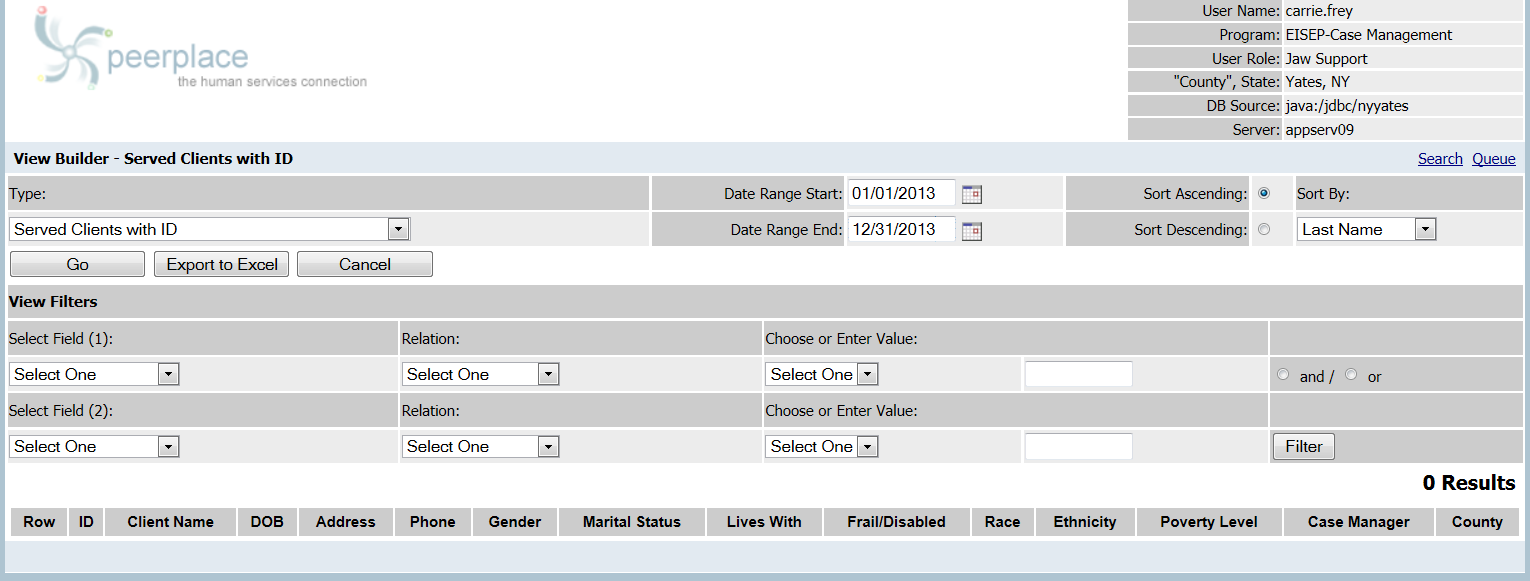
“Served Client with ID” View Builder View
B-1
-


Appendix C
Instructions for AAA Access to the Survey Website &
How to Submit Data
Please note: Screen shots will be updated to reflect website changes for the
Ninth National Survey.
AoA National Survey of Older Americans Act Participants
Instructions for AAA/SUA Access to the Website
To safeguard private, personally identifiable client contact information and to improve communication, we have created a secure website for the AoA National Survey of Older Americans Act Participants. State Units on Aging and Area Agencies on Aging will be able to submit electronic files containing confidential client data to Westat via the AoA National Survey web site. Included in the notification packet sent to each SUA and AAA is a separate card with the unique SUA-ID# or AAA-ID # and secure password assigned to your agency that will enable your staff to electronically upload data to the web site.
The web site uses the industry-standard SSL (Secure Socket Layer) encryption for secure File Transport Protocol (FTP) data submissions. When files containing client data are uploaded to the website, they are automatically stored in a secure database. The database containing the client data is not accessible via the Internet; it resides on a server inside the Westat firewall. Only Westat Data Collection Program staff members have access to the master survey database.
This document describes how to access the AoA National Survey Web Site: www.aoasurvey.org. You will use this web site to upload your client lists and client contact information and to retrieve sampling results (the list of clients selected to participate in the survey), as well as to download additional instructions and forms.
Step 1: Go to www.aoasurvey.org. You will automatically be redirected to https://aoasurvey.org/default.asp.
The Welcome page is available to the general public and can be accessed by any of your clients and their families who wish to know more information about the AoA National Survey.
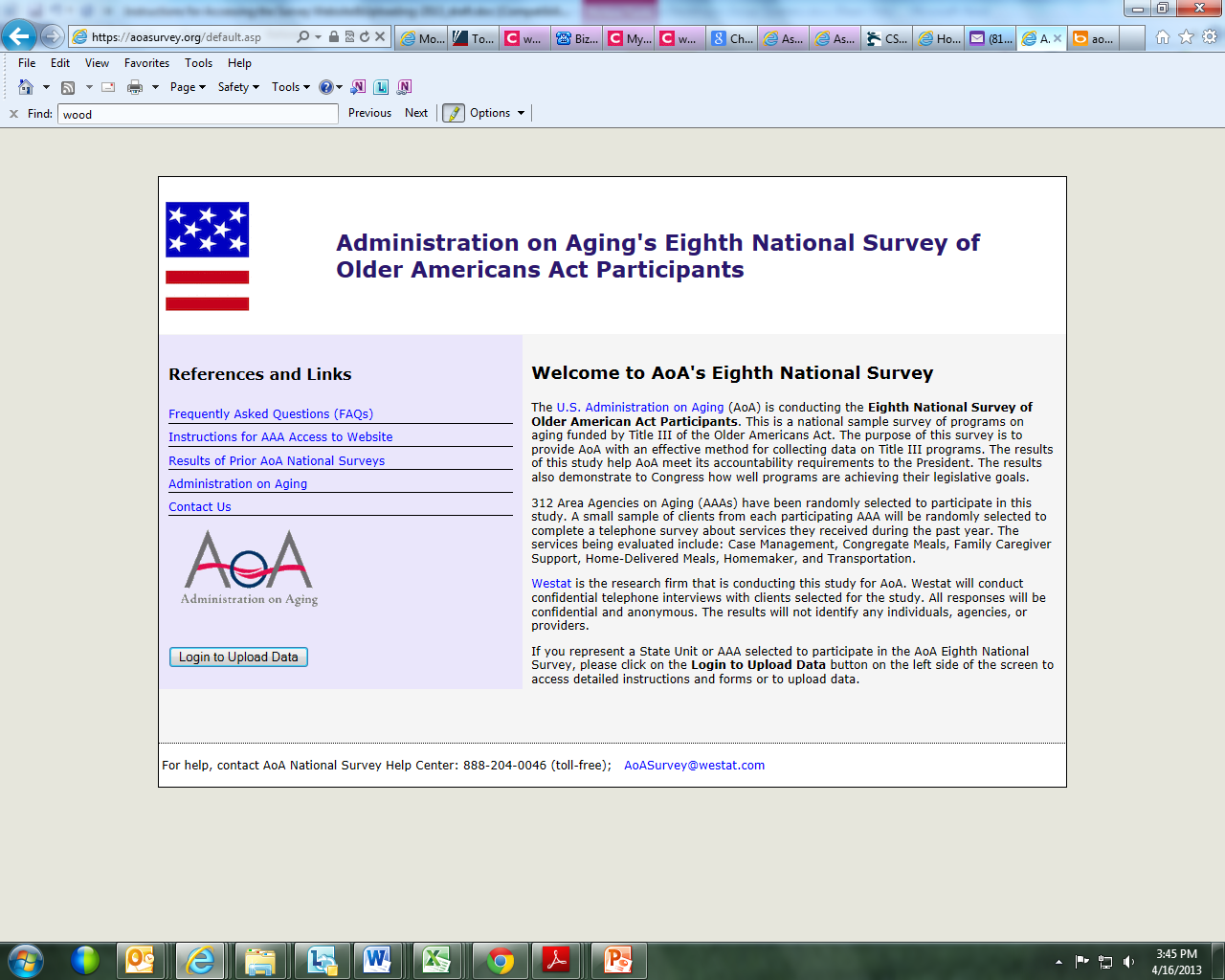
Step 2: Login to upload data or download instructions and forms.
To login to the secure part of the website, click on Login to Upload Data.


Step 3: At the AAA/SUA Login page, enter your AAA-ID or SUA-ID number and password and click, “Submit.”

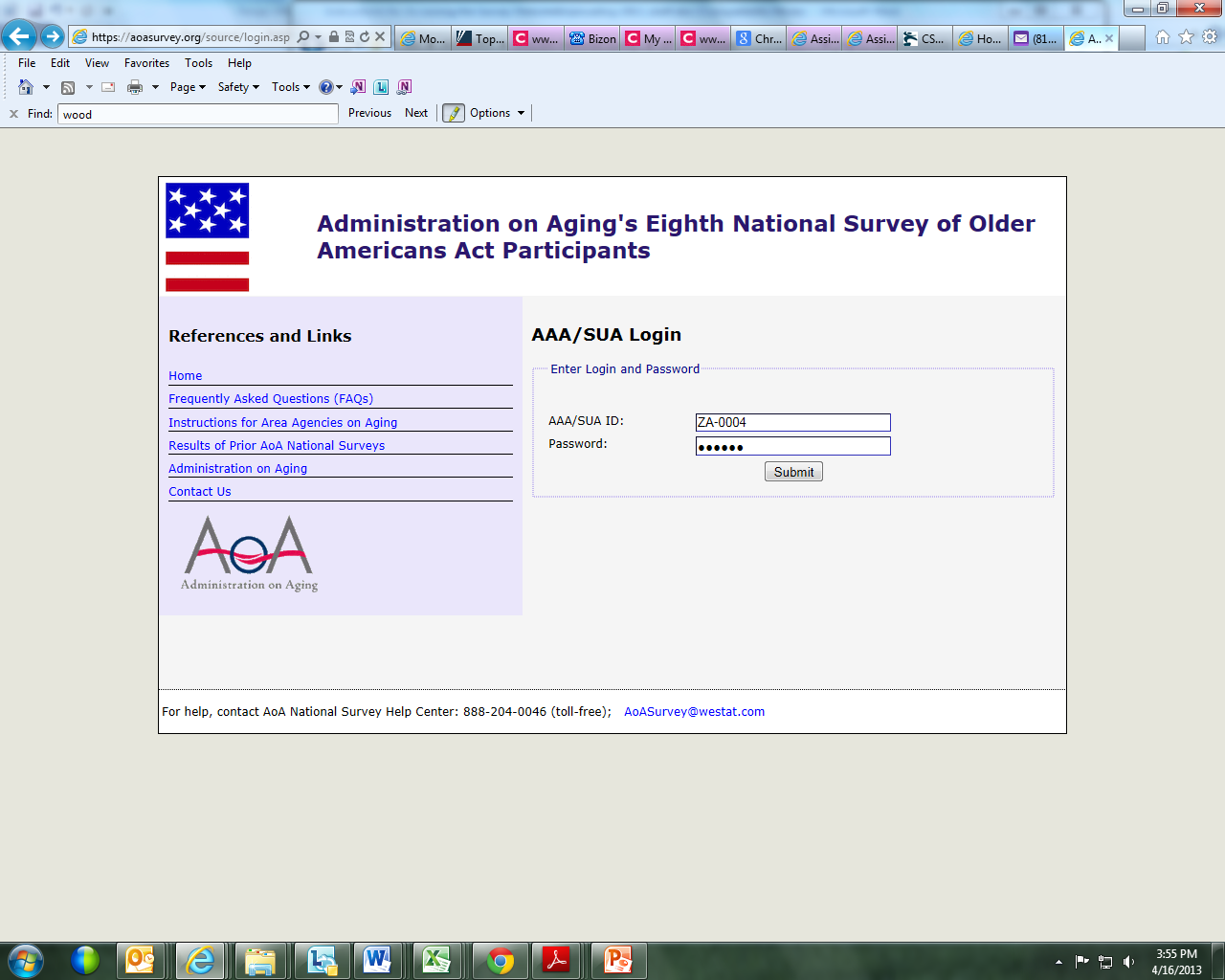
Step 4: Upload Client Data; Download Instructions and Forms
This screen is only accessible to SUAs and AAAs that have logged in with their SUA-ID# or AAA-ID# and password. There are two major components to this page:
On the left-side of the web page are copies of instructions and forms that you can download.

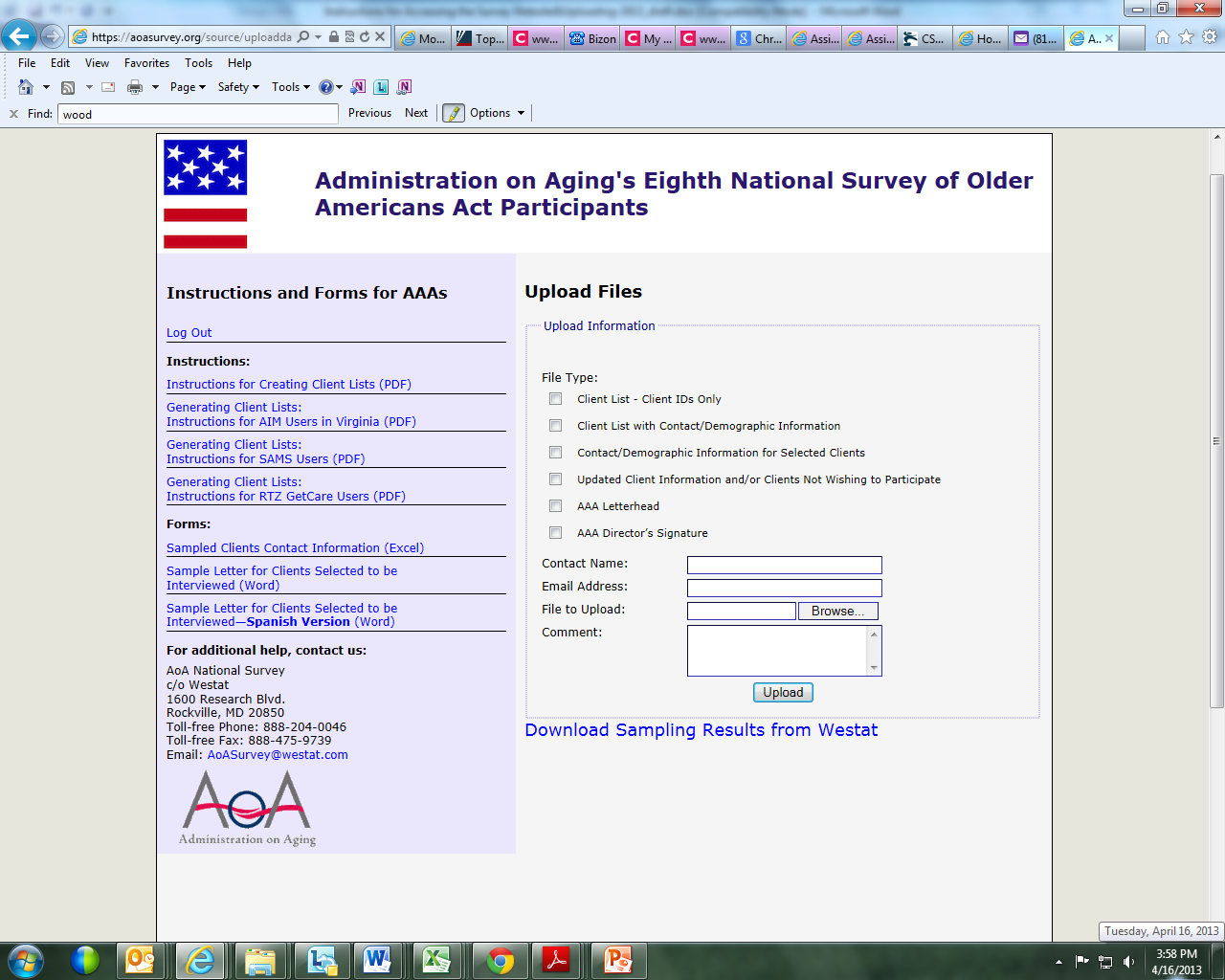
On the right-side of the web page, you can upload your client lists, client contact information, and AAA letterhead and signature.
To upload a file, select File Type and check one of the appropriate six options.
Please fill in the Contact Name and Email Address.
To upload a specific file, click Browse. A window will open which says, Choose File to Upload. Scroll to the folder location to select the file or files you want to upload.

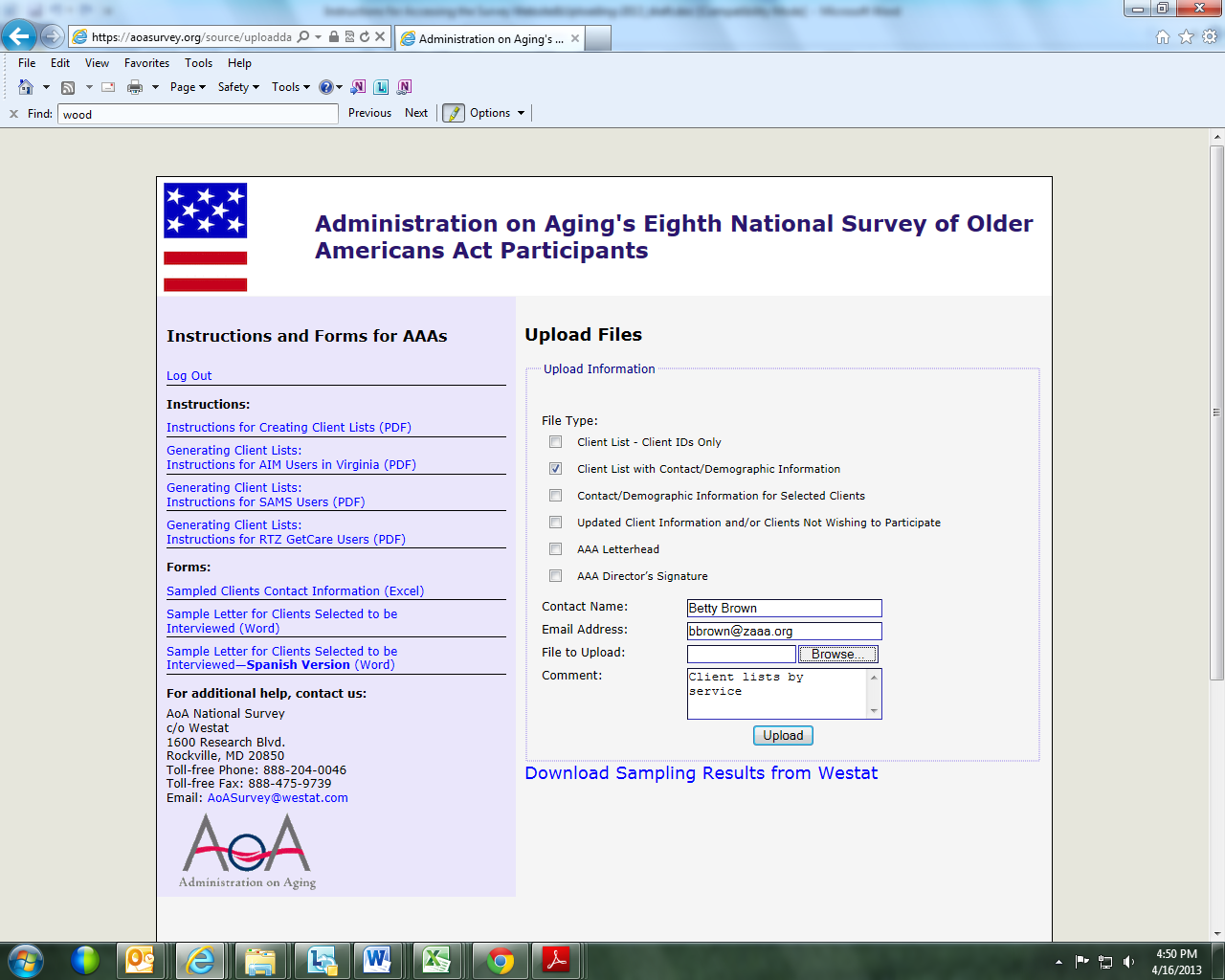
Click on the specific file that you want to upload, and your choice will be highlighted in blue. When you are satisfied that you have selected the correct file, click Open.


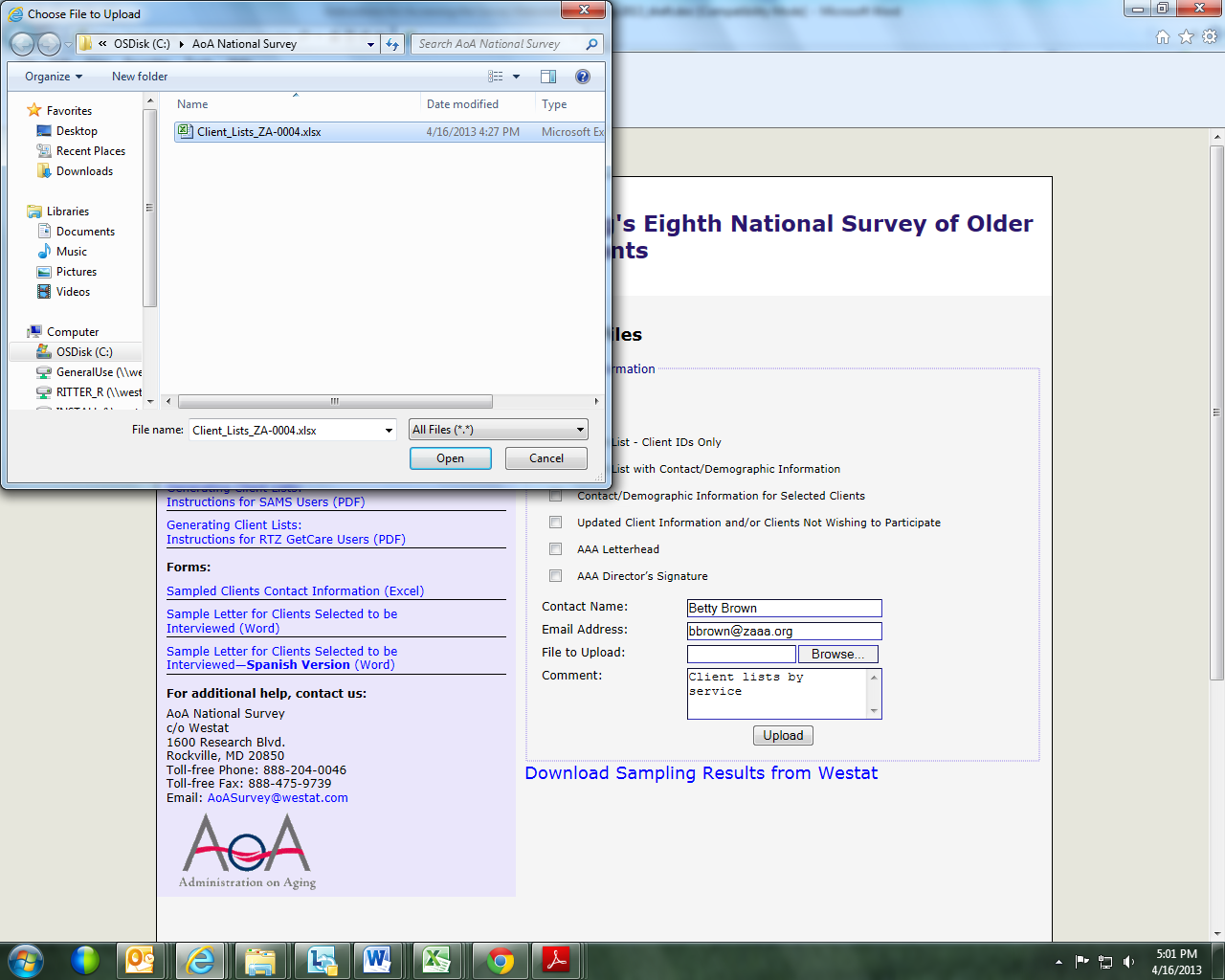
The file that you have selected and opened will appear in the box File to Upload.
If you wish to include any comments, please enter them in the Comment box.
Click Upload and your data will automatically be received by Westat.
PLEASE NOTE: You can only upload one file at a time. For multiple files, you will have to repeat this process for each separate file.

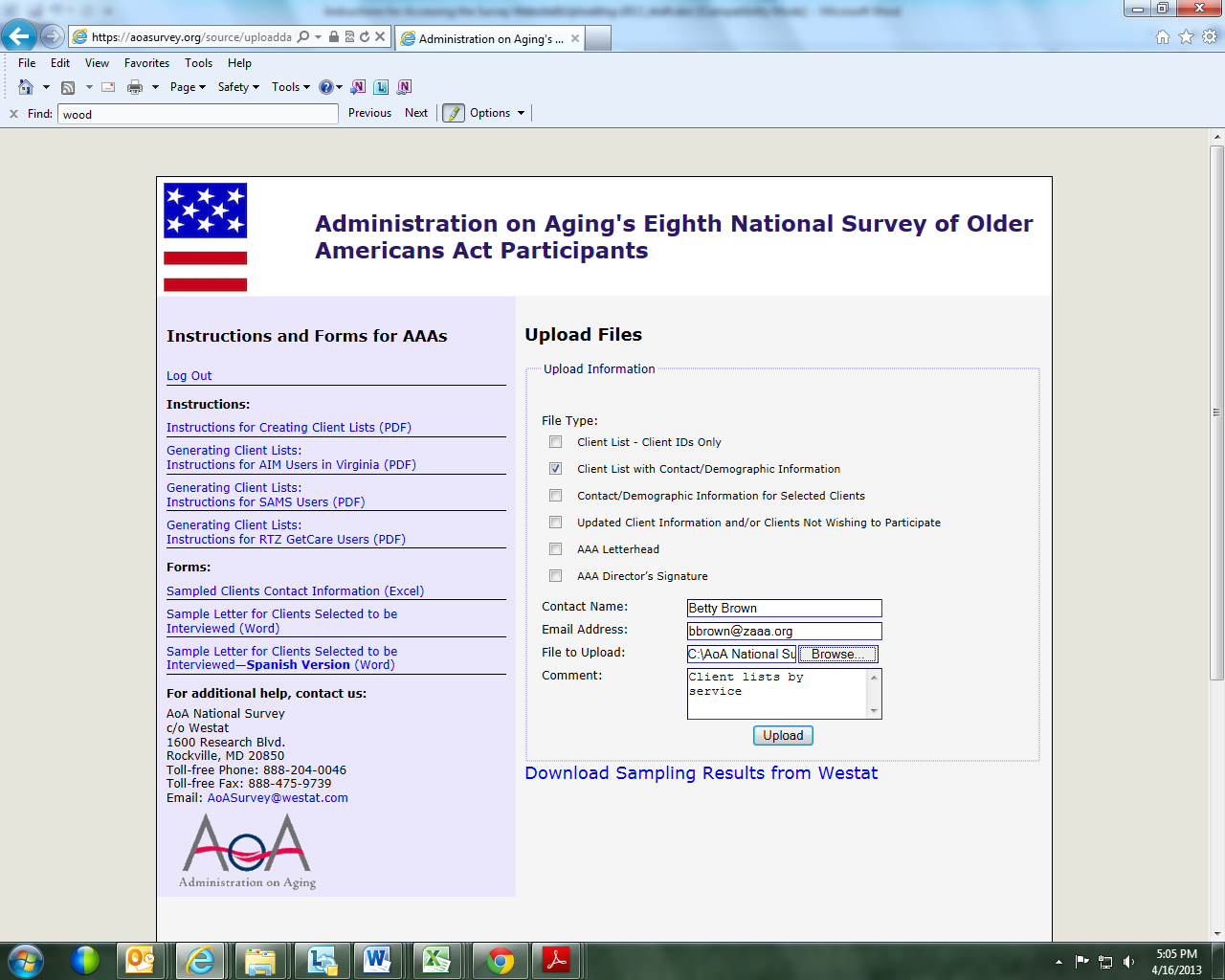
When the file has been uploaded, you will see a message in red which says,
Files successfully submitted. Select another file?

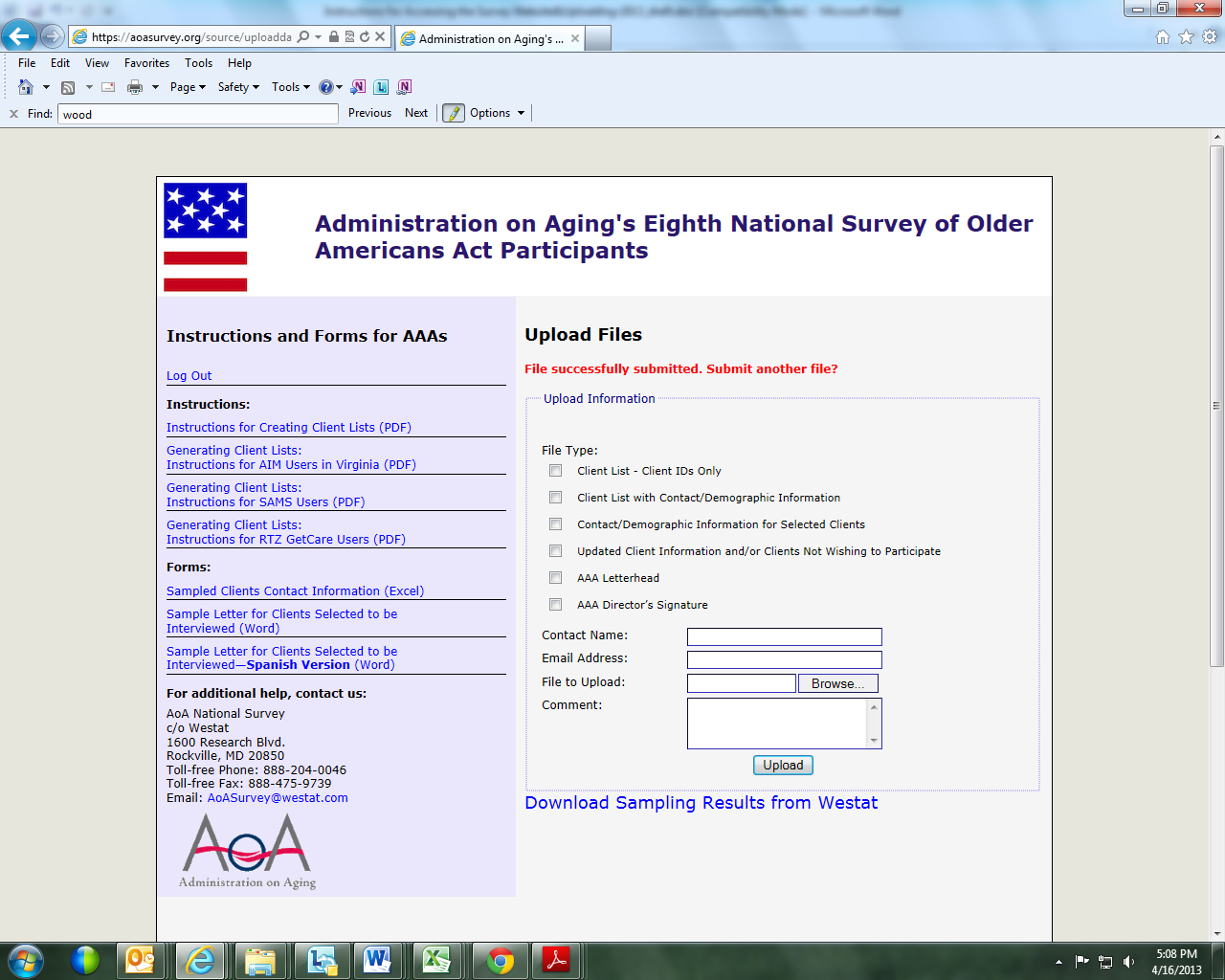
Step 5: Download sampling results.
If the original client lists that you submitted to Westat contained contact information for all of your clients, Westat will use this information to fill out the Sampled Clients Contact Information form for the clients randomly selected during the sampling procedure. Westat will upload the completed or partially-completed Sampled Clients Contact Information form to your password-protected portion of the website, so that you can download it to your agency’s computer system. We will let you know if additional information is needed on the form.
To download the sampling results provided on a completed or partially-completed Sampled Clients Contact Information form, log into the secure portion of the website using your AAA-ID and password (see Step 2).
On the right-side of the screen, under the Upload Files box, click on the hyperlink that says, Download Sampling Results from Westat.

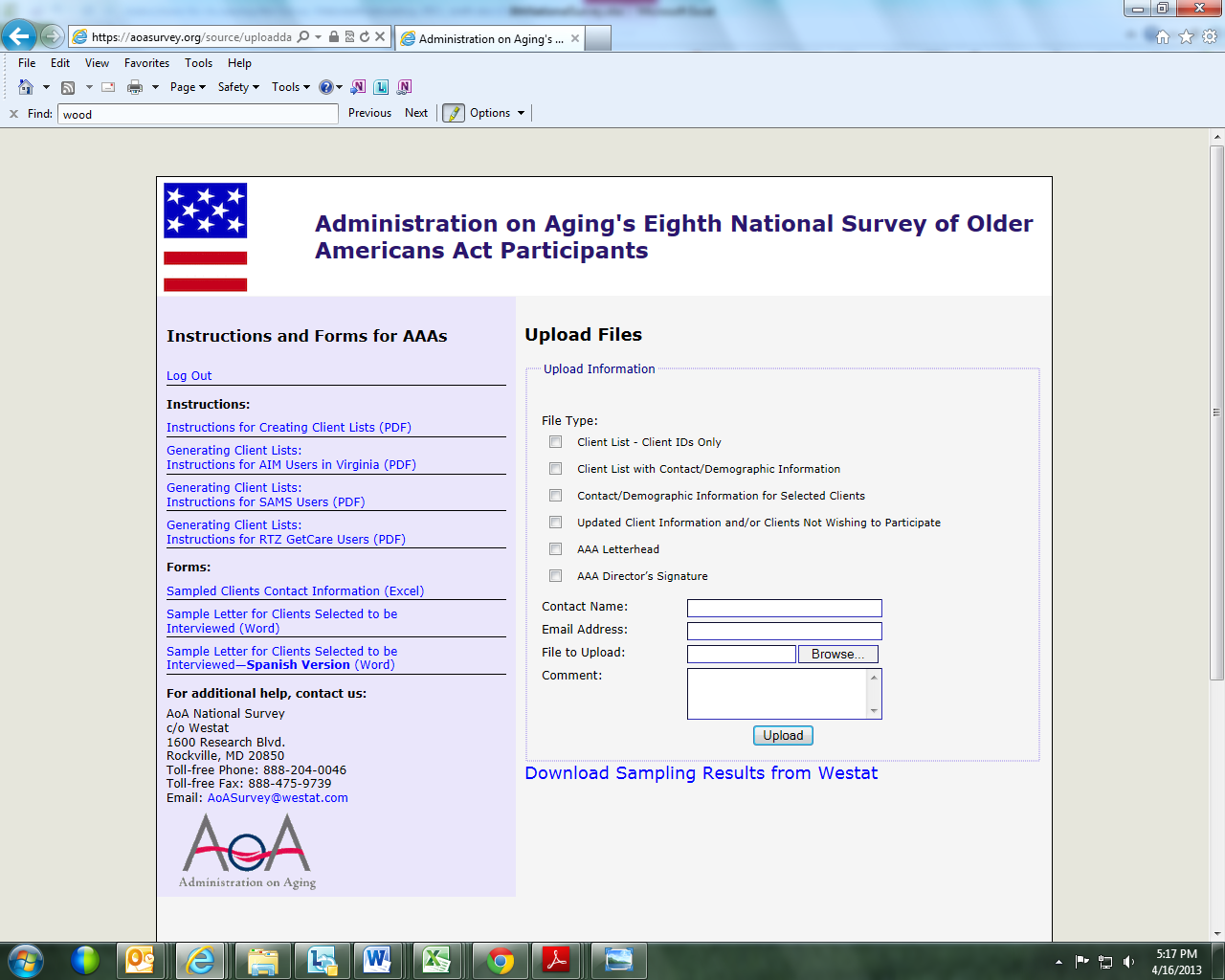

A new page will open which displays Agency Uploaded Files. The file that Westat has uploaded for your agency has been named for your AAA and is displayed in blue font in the box under the heading that says File Name.
Click on the file name displayed in blue font to open and download the file.

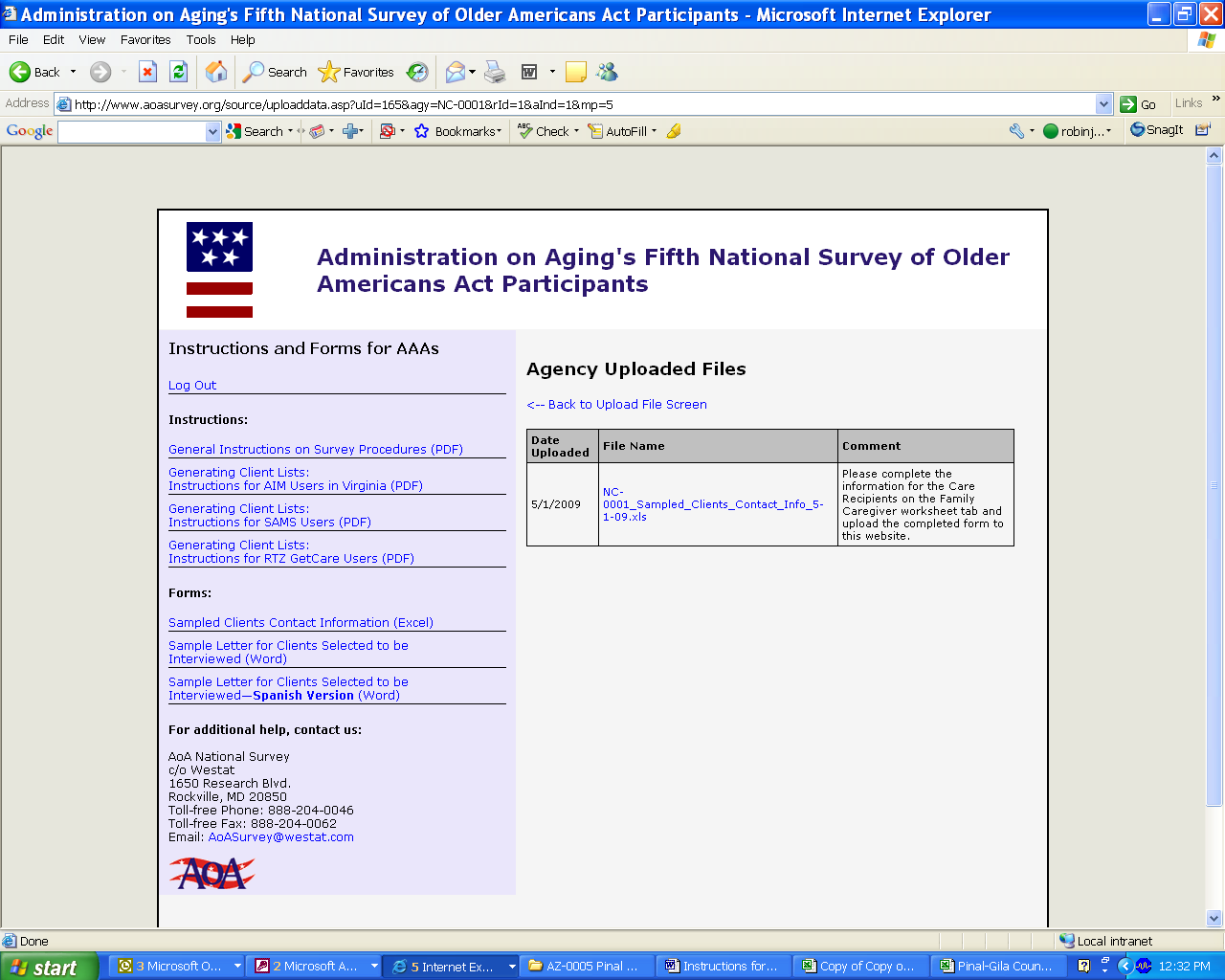
You will see a File Download dialogue box. Save the file to your computer.
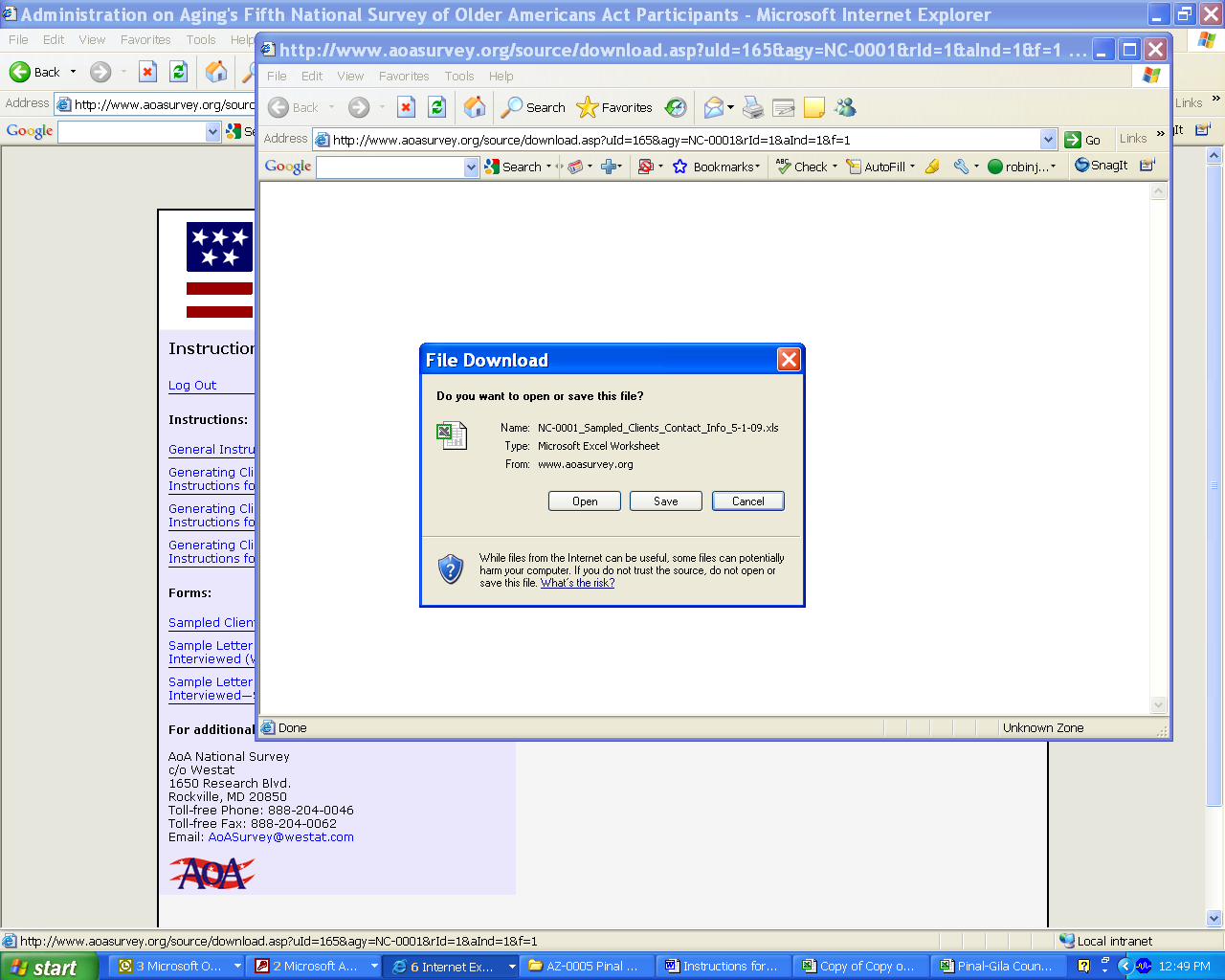
The Sampled Clients Contact Information form will show you which clients have been randomly selected for the telephone survey. If your Westat Survey Specialist has asked you for additional information on these clients, please fill in the missing information and resave your file to your computer.
When you have completed filling in the missing information, please upload your completed Sampled Clients Contact Information form to the website (see Step 4-2) and select Client Info for File Type.
Step 6: Log out when you have finished uploading files or downloading sampling results, instructions, and forms.
If at any time you need help with the AoA National Survey website, please contact the AoA National Survey Help Center at 888-204-0062 or by email at [email protected].

Appendix D
Federal Register Notice
Published by the
Administration for Community Living/
Administration on Aging
For the Proposed Information Collection
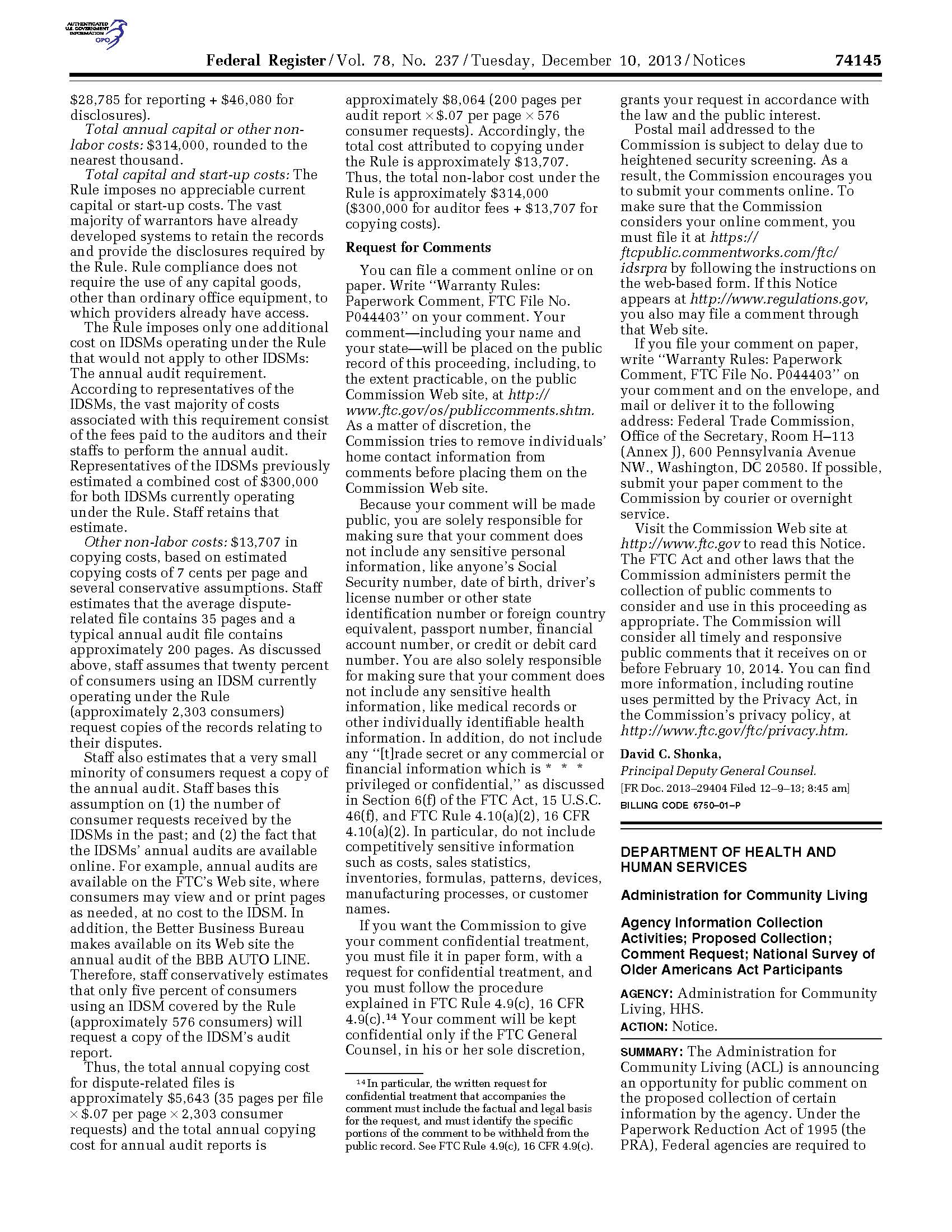
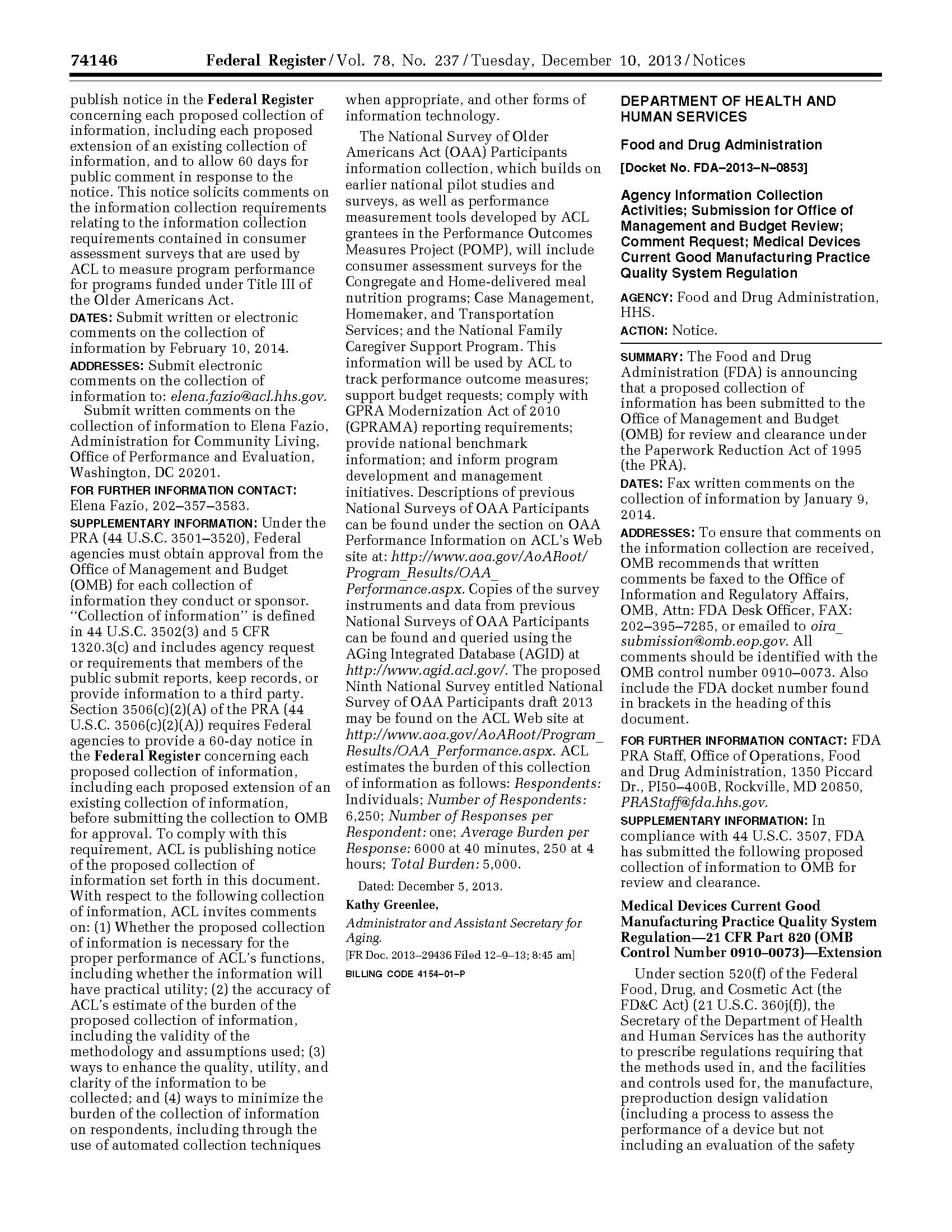 DS
Appendix E
DS
Appendix E
Westat Assurance of Confidentiality Agreement S
Westat, Inc.
Employee or Contractor’s Assurance of Confidentiality of Survey Data
Statement of Policy
Westat is firmly committed to the principle that the confidentiality of individual data obtained through Westat surveys must be protected. This principle holds whether or not any specific guarantee of confidentiality was given at time of interview (or self-response), or whether or not there are specific contractual obligations to the client. When guarantees have been given or contractual obligations regarding confidentiality have been entered into, they may impose additional requirements that are to be adhered to strictly.
Procedures for Maintaining Confidentiality
1. All Westat employees and field workers shall sign this assurance of confidentiality. This assurance may be superseded by another assurance for a particular project.
2. Field workers shall keep completely confidential the names of respondents, all information or opinions collected in the course of interviews, and any information about respondents learned incidentally during field work. Field workers shall exercise reasonable caution to prevent access by others to survey data in their possession.
3. Unless specifically instructed otherwise for a particular project, an employee or field worker, upon encountering a respondent or information pertaining to a respondent that s/he knows personally, shall immediately terminate the activity and contact her/his supervisor for instructions.
4. Survey data containing personal identifiers in Westat offices shall be kept in a locked container or a locked room when not being used each working day in routine survey activities. Reasonable caution shall be exercised in limiting access to survey data to only those persons who are working on the specific project and who have been instructed in the applicable confidentiality requirements for that project.
Where survey data have been determined to be particularly sensitive by the Corporate Officer in charge of the project or the President of Westat, such survey data shall be kept in locked containers or in a locked room except when actually being used and attended by a staff member who has signed this pledge.
5. Ordinarily, serial numbers shall be assigned to respondents prior to creating a machine-processable record and identifiers such as name, address, and Social Security number shall not, ordinarily, be a part of the machine record. When identifiers are part of the machine data record, Westat’s Manager of Data Processing shall be responsible for determining adequate confidentiality measures in consultation with the project director. When a separate file is set up containing identifiers or linkage information which could be used to identify data records, this separate file shall be kept locked up when not actually being used each day in routine survey activities.
6. When records with identifiers are to be transmitted to another party, such as for keypunching or key taping, the other party shall be informed of these procedures and shall sign an Assurance of Confidentiality form.
7. Each project director shall be responsible for ensuring that all personnel and contractors involved in handling survey data on a project are instructed in these procedures throughout the period of survey performance. When there are specific contractual obligations to the client regarding confidentiality, the project director shall develop additional procedures to comply with these obligations and shall instruct field staff, clerical staff, consultants, and any other persons who work on the project in these additional procedures. At the end of the period of survey performance, the project director shall arrange for proper storage or disposition of survey data including any particular contractual requirements for storage or disposition. When required to turn over survey data to our clients, we must provide proper safeguards to ensure confidentiality up to the time of delivery.
8. Project directors shall ensure that survey practices adhere to the provisions of the U.S. Privacy Act of 1974 with regard to surveys of individuals for the Federal Government. Project directors must ensure that procedures are established in each survey to inform each respondent of the authority for the survey, the purpose and use of the survey, the voluntary nature of the survey (where applicable) and the effects on the respondents, if any, of not responding.
PLEDGE
I hereby certify that I have carefully read and will cooperate fully with the above procedures. I will keep completely confidential all information arising from surveys concerning individual respondents to which I gain access. I will not discuss, disclose, disseminate, or provide access to survey data and identifiers except as authorized by Westat. In addition, I will comply with any additional procedures established by Westat for a particular contract. I will devote my best efforts to ensure that there is compliance with the required procedures by personnel whom I supervise. I understand that violation of this pledge is sufficient grounds for disciplinary action, including dismissal. I also understand that violation of the privacy rights of individuals through such unauthorized discussion, disclosure, dissemination, or access may make me subject to criminal or civil penalties. I give my personal pledge that I shall abide by this assurance of confidentiality.
________________________________________
Signature
_________________________________________
Printed Name
_________________________________________
Date
-
Appendix F
Agency Information Packet:
Letter to Area Agencies on Aging
Memo and Sampling Instructions
Pre-notification Client Information Letter
Sampled Client Contact Information Form

DATE: |
May __, 2014 |
|
|
TO: |
Executive Director, Area Agency on Aging |
|
|
FROM: |
Robert Hornyak
|
SUBJECT: |
Ninth National Survey of Older Americans Act Participants |
The seniors you serve can influence decision makers. The Administration on Aging would like to contact a sample of senior citizens served by your organization for a national survey. The survey results will demonstrate to the President, Congress, and other decision makers the outstanding outcomes that the Aging Network produces. Powerful information from surveys is used for performance outcome measures, to support AoA budget requests, and to enhance our continued pursuit of support for long term care services and supports (LTSS).
Performance measurement is critical to improving LTSS for all consumers. I am writing this letter to ask your assistance in the Ninth National Survey of Older Americans Act Participants. This survey provides AoA with an effective method for collecting timely data to meet the accountability requirements of Congress and the executive branch of the federal government. The results of this survey can also be used for your own advocacy and business purposes. Your agency has been chosen to participate in AoA’s 2014 National Survey. Although your participation in the survey is voluntary, your cooperation is essential to the success of this survey.
As required, AoA requested and received approval from the Office of Management and Budget (OMB) to identify and to survey elderly individuals who receive OAA services (OMB approval number is 0985-0023). The approval covers the sampling of area agencies on aging and their clients, and conducting surveys to assess the following service categories: congregate and home-delivered meals, caregiver, case management, homemaker, and transportation services.
Westat is the contractor responsible for conducting the survey. We are asking for your assistance in selecting service recipients to be interviewed for the survey. The enclosed instructions describe the steps you will need to take to help select these participants. The survey will determine consumer assessment of the services they receive, as well as outcomes of those services for participants. All of their responses will be completely confidential and the analysis will not be linked with either individuals or your agency. We anticipate the development of survey samples will take you about two hours to complete. You will be working with Robin Ritter and her staff from Westat to complete this procedure. If you have any questions, you may call her at 1-888-204-0046.
If you have any questions about your participation in the survey, please call ACL at 1-888-204-0271. On behalf of the Administration on Aging, U.S. Department of Health and Human Services, I would like to thank you for your assistance in this project. Your help is invaluable for the completion of this study.
Sincerely,

Robert Hornyak
Director, Office of Performance and Evaluation
Center for Disability and Aging Policy
cc: <<ACL Regional Administrator>>, Regional Administrator


WESTAT
An Employee-Owned Research Corporation

memorandum
DATE: |
<DATE> |
|
|
TO: |
|
|
|
FROM: |
Robin Ritter, Manager of Survey Operations |
|
|
SUBJECT: |
AoA Ninth National Survey of Older Americans Act Participants |
Westat is conducting the Ninth National Survey of Older Americans Act Participants for the Administration for Community Living, U. S. Department of Health and Human Services. Your Agency was selected as part of a representative sample of all Area Agencies on Aging in the United States, and your participation is essential for the success of this study.
You will be assisting ACL by providing information that will allow Westat, ACL’s contractor, to survey individual clients and caregivers who receive OAA services. We will work with your staff to randomly select clients and caregivers to take part in a telephone survey to assess OAA programs. The data collected from the survey will be used to document the outcomes of services provided by the Aging Network.
Services that are being evaluated include:
Case Management
Congregate Meals
Home Delivered Meals
Homemaker Services
Transportation Services
National Family Caregiver Support Program
Enclosed you will find instructions on how clients will be randomly selected for the survey and your agency’s role in that process. If you have any questions or concerns, please do not hesitate to contact us:
By telephone: 1-888-204-0046 (toll free)
By email: [email protected].
We are looking forward to working with you and your staff, and we are committed to making this study as efficient and effective as possible. Thank you for your participation.
Contents Page
Letter from the Administration for Community Living (separate page)
Memo from Westat 1
Summary of AAA Responsibilities 2
Instructions for Creating Client Lists (Checklist) 3
Detailed Instructions for the Ninth AoA National Survey of OAA Participants 5
Older Americans Act Title III Service Definitions 9
Sample Letter for Clients Selected to be Interviewed 12
Login & Password/Instructions for Accessing the AoA National Survey Website (separate pages)
Summary of AAA Responsibilities for the Ninth AoA National Survey
Summary of Responsibilities of the AAA Executive Director:
Please designate a person within your agency to be a survey liaison or point-of-contact with whom we will work to gather and complete the necessary client lists and client contact information.
Please provide us with the contact person’s name, email address, and phone number in an email message to our secure mailbox: [email protected] or call us at 1-888-204-0046.
Summary of Responsibilities of the AAA’s Survey Liaison:
Step 1: Generate separate lists of active OAA clients by service. Six services are being studied this year and are outlined further on in this memo.
Step 2: Upload the service lists to the AoA Survey secure website. Westat staff will use a special computer program to randomly select clients from your service lists who will be interviewed for the study, and we will inform you of the specific clients selected.
Step 3: Provide Westat staff with contact information for those clients selected to be interviewed. Forms (Excel) for recording the contact information for the clients selected to be interviewed can be downloaded from the AoA National Survey website https://aoasurvey.org/default.asp or you may use your own spreadsheets, provided that the required contact information is included for each client.
Step 4: Notify the clients selected to be interviewed about the study. A sample letter is provided in this packet; you can also download a copy of this sample letter from the AoA National Survey website https://aoasurvey.org/default.asp. To save time and the cost of postage, Westat can create and mail the letter for you on your AAA’s letterhead, if desired.
Step 5: Notify Westat of any clients who do not wish to participate or whose contact information has changed. More detailed instructions are included on the pages following this section. Your Westat Survey Specialist will work with you to accommodate scheduling concerns, data format issues, or any other problems you might foresee or encounter.
Instructions for Creating Client Lists
Generate separate lists of active Older Americans Act Title III clients by type of service received using your client tracking software using either the one-step or two-step method.
One-step method: Generate separate lists (separate Excel worksheet tabs or files) of clients by service and include all client contact information needed for clients selected to be interviewed (see chart on next page).
Upload separate service lists to AoA Survey website https://aoasurvey.org/source/login.asp.
Westat survey specialists will use a specialized computer program to randomly select a small number of clients per service to be interviewed.
Westat will notify AAA of the clients that were selected by uploading list of selected clients to the AAA’s secure portion of the AoA Survey website.
Westat will destroy client contact information for any clients who were not selected to be interviewed.
Client contact information for clients selected to be interviewed will be used to send the informed consent letters and to contact the clients for their interviews; all client contact information will be destroyed by 12/31/14.
Two-step method:
Step 1: Generate separate lists of clients by service using client IDs only.
Upload separate service lists to AoA Survey website https://aoasurvey.org/source/login.asp.
Westat survey specialists will use a specialized computer program to randomly select a small number of clients per service to be interviewed and will notify AAA of the client IDs that were selected.
Step 2: Provide detailed client contact information for the client IDs that were randomly selected (see chart on next page).
Upload client contact information on the Sampled Clients Contact Information form (Excel) or alternate Excel format.
Client contact information for clients selected to be interviewed will be used to send the informed consent letters and to contact the clients for their interviews; all client contact information will be destroyed by 12/31/14.
Things to consider regardless of which method you use to create your client lists for sampling:
Each list should consist of clients who have received the OAA services during the most recent 12 month period.
Before you select your lists of clients, if possible, select clients who are CURRENTLY ACTIVE; please do not include any clients who are known to be deceased or have moved out of the area.
Each client who received the service will need to be listed on a separate line. Clients can be represented by a client ID (not a Social Security Number).
For the five (5) non-caregiver services, the following information is needed for each client selected to be interviewed:
Case Management |
Congregate Meals |
Home-Delivered Meals |
Homemaker |
Transportation |
OAA Title III-B |
Title III-C1 |
Title III-C2 |
Title III-B |
Title III-B |
Clients age 60+ |
Clients age 60+ |
Clients age 60+ |
Clients age 60+ |
Clients age 60+ |
Client Name |
Client Name |
Client Name |
Client Name |
Client Name |
Client Phone |
Client Phone |
Client Phone |
Client Phone |
Client Phone |
Client DOB |
Client DOB |
Client DOB |
Client DOB |
Client DOB |
Client Gender |
Client Gender |
Client Gender |
Client Gender |
Client Gender |
Client Address |
Client Address |
Client Address |
Client Address |
Client Address |
Client City |
Client City |
Client City |
Client City |
Client City |
Client State |
Client State |
Client State |
Client State |
Client State |
Client Zip Code |
Client Zip Code |
Client Zip Code |
Client Zip Code |
Client Zip Code |
Service Provider |
Service Provider |
Service Provider |
Service Provider |
Service Provider |
For Family Caregiver services, the following information is needed for each client selected to be interviewed:
National Family Caregiver Support Program
|
Title III-E clients who receive any of the following: Counseling and Support, Respite Services, and Supplemental Services (I&A and Grandparents Caring for Grandchildren are excluded) |
Caregiver Name (persons providing care for persons age 60 years and older) |
Caregiver Phone |
Caregiver Date of Birth |
Caregiver Gender |
Caregiver Address |
Caregiver City |
Caregiver State |
Caregiver Zip Code |
Service Provider |
Care Recipient Name (Persons receiving care age 60 or older) |
Care Recipient Date of Birth (Age 60 or older) |
Care Recipient Gender |
Detailed Instructions for the
Ninth AoA National Survey of OAA Participants
Generate separate numbered lists of OAA clients by type of service received using your client tracking software. Instructions for creating numbered client lists for Virginia’s version of AIM or PeerPlace are included in this packet. Please refer to the “Instructions for Creating Client Lists” on pages 3-4 to determine if you wish to use the “one-step” or “two-step method.” Each list should consist of clients who have received the following services during the most recent 12 month period. Note: before you select your lists of clients, please do not include any clients who are known to be deceased or have moved out of the area. Each client who received the service will need to be listed on a separate row. You will need to have six separately numbered lists for each of the following:
Case Management
Congregate Meals
Home-delivered Meals
Homemaker Services
Transportation Services (Please do not include clients who receive assisted transportation services.)
Caregivers caring for care recipients age 60 or older who received any of the following services through the National Family Caregiver Support Program (except those who received information and assistance services only):
Individual counseling, participation in support groups, and/or caregiver training to assist the caregivers in making decisions and solving problems relating to their caregiving roles
Respite care to enable caregivers to be temporarily relieved from their caregiving responsibilities
Supplemental services, on a limited basis, to complement the care provided by caregivers.
Please do not include caregivers who have received information and assistance services only, and please do not include grandparents caring for grandchildren or anyone caring for individuals who are less than 60 years old.
Upload the service lists to the AoA Survey secure website.
Upload your file(s) containing your numbered client lists by service to the AoA National Survey secure website https://aoasurvey.org/default.asp. You will be required to log-in with your unique AAA-ID or SUA-ID and password, and provide the name of the person uploading the file.
Your Westat Survey Specialist will enter your client service list totals into a special computer program which will randomly select clients by row numbers from each of your numbered lists. The randomly selected row numbers indicate the client IDs or client names selected for the survey.
If you use the two-step method and submit service lists with client IDs only, your Westat Survey Specialist will provide you with the sampling results showing the specific client IDs representing the clients selected to be interviewed for the survey. You will then need to provide Westat with the client names and contact information that corresponds to the selected client IDs.
If you use the one-step method and submit service lists with all client names and contact information included in advance, your Westat Survey Specialist will upload the sampling results to your AAA secure portion of the AoA survey website. The sampling results will list the specific clients selected to be interviewed for the survey; all non-selected clients will have been deleted. You can disregard Step 3 below and move to Step 4 (notify selected clients).
If you used the two-step method and submitted only client IDs, you will need to provide Westat with client names and contact information for only those clients IDs selected on the random sampling report. You can use the Sampled Clients Contact Information Form (an Excel file) to record client contact information; the form can be downloaded from the AoA National Survey secure website https://aoasurvey.org/default.asp. If you prefer, you can use an alternate Excel format of your choice as long as it contains the required contact information for each client.
For Care Management, Congregate Meals, Home Delivered Meals, Homemaker Service, and Transportation, the following information is needed for each client selected to be interviewed:
Client name (Last Name; First Name)
Client telephone number
Client date of birth
Client gender
Client address
Service Provider
Any accommodations, if known, that the client would need to complete the telephone survey. A proxy (usually a relative or a caregiver) may be designated to answer the survey questions on the client’s behalf due to speech, language, hearing, cognitive or other difficulties. Similarly, an interpreter may be designated to answer the survey questions for non-English speaking clients.
For Caregivers, the following information is needed for each Caregiver selected to be interviewed
Caregiver name
Client telephone number
Caregiver date of birth
Caregiver gender
Caregiver address
Any accommodations, if known, that the caregiver would need to complete the survey (e.g., a proxy or an interpreter may be designated to answer the survey questions on the caregiver’s behalf due to speech, language, hearing, or other difficulties or for non-English speaking caregivers).
For caregivers, we are also asking for the name, date of birth, and gender of the person they are caring for (if the information is available).
Provide Westat with the contact information for the clients and caregivers by one of the following methods ranked in order of most secure:
Upload the completed Sampled Clients Contact Information Form or other file containing client contact information to the AoA National Survey secure website https://aoasurvey.org/default.asp.
If you experience difficulty using the secure website, you can send the information via email to the secure email account: [email protected]. If selecting this method, please password-protect your file and send the password to Westat in a separate email message.
Send the information to Westat by Federal Express (Westat will provide you with prepaid Federal Express shipping labels when requested):
Westat
ATTN: Robin Ritter
1600 Research Blvd
RW 3658
Rockville, MD 20850
Fax the information to: 888-475-9739 (toll-free).
We would like to have this process completed by June 30, 2014, if possible.
Notify the clients selected to be interviewed about the study and the importance of their participation. A sample informed consent letter is provided in this packet; you can also download the Sample Letter to Notify Clients Selected to be Interviewed as a Word file from the AoA National Survey website https://aoasurvey.org/default.asp. A separate Spanish language version of the letter can also be downloaded from the website. Please send each client who was selected a letter requesting his/her participation in the study using your agency’s letterhead. This will let your clients know that this is a legitimate telephone survey and how important the study is. Please check with your Westat Survey Specialist for guidance on when to mail the letter. Alternatively, Westat can mail the client letters for your agency if you provide us with your agency letterhead. You can upload Word or jpg files containing your letterhead and executive director’s signature to the AoA National Survey secure website.
Notify Westat of any clients who do not wish to participate, are unable to participate, or whose contact information has changed. After receiving the letter, if a client notifies you that they do not want to participate or you find that they are no longer able to participate (moved, nursing home placement, death), please upload the updated client information to the AoA National Survey website or notify your Westat Survey Specialist, and we will remove the client’s name and contact information from our lists of clients to be called for the survey. Otherwise, telephone interviews are scheduled to start the week of July 15, 2014 and will continue into October.
Older Americans Act Title III Service Definitions
Case Management (Title III B)
A client-centered service providing assistance in the form of care coordination or access
Activities include needs assessment; care plan development and implementation; case coordination (authorizing and arranging for services, coordinating the provision of services among providers); follow-up and reassessment of client status.
Homemaker Services (Title III B)
Homemaker services provide assistance with specific home management duties for persons having difficulty with one or more of the following instrumental activities of daily living (IADL): preparing meals, managing money, shopping for groceries or personal items, performing light or heavy housework, and using a telephone.
Transportation (Title III B)
Providing transportation to or from health and medical care, community services, recreational activities, and shopping
Eligible clients are those who have difficulties (physical or cognitive) using regular transportation.
Congregate Meals/Congregate Nutrition Services (Title III C-1)
The provision of a meal at a congregate meal site
Home Delivered Meals (Title III C-2)
A meal delivered to the home of an eligible client or other eligible participant
National Family Caregiver Support Program (Title III E)
For this study, a Family Caregiver participant in the National Family Caregiver Support Program is defined as an individual who is providing care for another adult family member 60 years of age or over in the home. The person for whom the Family Caregiver provides care for is the “Care Recipient.” Although the Care Recipient may receive other OAA services provided by the AAA, it is the Caregiver who provides care that is the focus of the Caregiver section of this study.
Registered Services:
Counseling: Provide individual counseling, organization of support groups, and caregiver training to family caregivers on an individual or group basis.
Respite Care: Provide temporary, substitute care arrangements to provide a brief period of rest or relief for family caregivers.
Supplemental Services: Services to complement the care provided by family caregivers such as emergency medical transportation not covered by insurance and other activities; home modifications not covered under Title IIIB, Medicare or other insurance
Please note the following exceptions for National Family Caregiver Support Program (Title III E):
Grandparents or other older individuals providing care for individuals less than 60 years of age are not eligible for this study and should not be included on client lists.
Information & Assistance for caregivers about available services is not included in this study. For this study, we are limiting the Caregiver survey to persons who are receiving registered Family Caregiver services (Counseling, Respite Care, and Supplemental Services). Although many individuals may also be receiving Information and Assistance (I&A), if I&A is the only service that they have received, they should not be included in the client lists for the survey.
Sources:
National Family Caregiver Support Program
http://www.aoa.gov/aoaroot/Press_Room/Products_Materials/fact/pdf/Natl_Family_Caregiver_Support.pdf
Outline of 2006 Amendments to the Older Americans Act http://www.aoa.gov/AoA_programs/OAA/oaa.aspx
Sample Letter for Clients Selected to be Interviewed
Tri-County Area Agency on Aging
123 Anywhere St.
Anywhere, XX 12345
<DATE>
Dear Mr./Mrs. ______________________________ ,
We are writing to ask for your help. <<INSERT AAA NAME>> is taking part in a study for the Administration for Community Living’s Administration on Aging (AoA), part of the U.S. Department of Health and Human Services. AoA wants to know what people around the country think about the meal programs, transportation, family caregiver, and other services offered by their local AAA.
You have been chosen to be part of this national study. An interviewer from Westat, a research firm working for AoA, will call you in the near future to ask you some questions about your experience with <<INSERT AAA NAME & PROVIDER NAME IF KNOWN>>. Your answers will be kept private. Your name won’t be given to anyone else.
Your answers will be combined with answers from other clients and will be part of a report to Congress about how well these services are meeting the needs of older Americans. AoA and Congress will use this information to help them decide how well the programs are working and what improvements to make. Your answers will be very important in helping AoA and Congress decide what to do.
I hope you will be part of this important study. It’s your choice. Whatever you decide, it won’t affect the services you get now or in the future. If you do not want to take part in this study, please call <<INSERT AAA CONTACT NAME>> at <<INSERT AAA PHONE NUMBER>> by <<INSERT DATE>>.
If you have any questions about this study, please call Westat toll-free at 1-888-204-0046 or the Administration on Aging toll-free at 1-888-204-0271. If you have any questions about the services you get, please call our office at <<INSERT AAA PHONE NUMBER>>.
Thank you for your help and support.
Sincerely,
______________________________,
Executive Director
Sincerely,
An agency may not conduct or sponsor, and a person is not required to respond to a collection of information unless it displays a currently valid OMB control number. The OMB control number for this information collection is xxxx-xxxx. Public reporting burden for this information collection is estimated to average 40 minutes per response; response times may range from 23 minutes to 6 minutes. Send comments regarding this burden estimate or any other aspect of this collection of information, including suggestions for reducing this burden to the Administration for Community Living, Washington, DC 20201 Attn: Dr. Elena Fazio, 202-357-3583.
4Ficke, R.C. Digest of Data on Persons with Disabilities. Washington, DC: National Institute on Disability and Rehabilitation Research, 1992.
| File Type | application/vnd.openxmlformats-officedocument.wordprocessingml.document |
| File Title | 7420.01: OMB Package. Section A. Introduction |
| Author | MARKOVICH_L |
| File Modified | 0000-00-00 |
| File Created | 2021-01-27 |
© 2025 OMB.report | Privacy Policy

